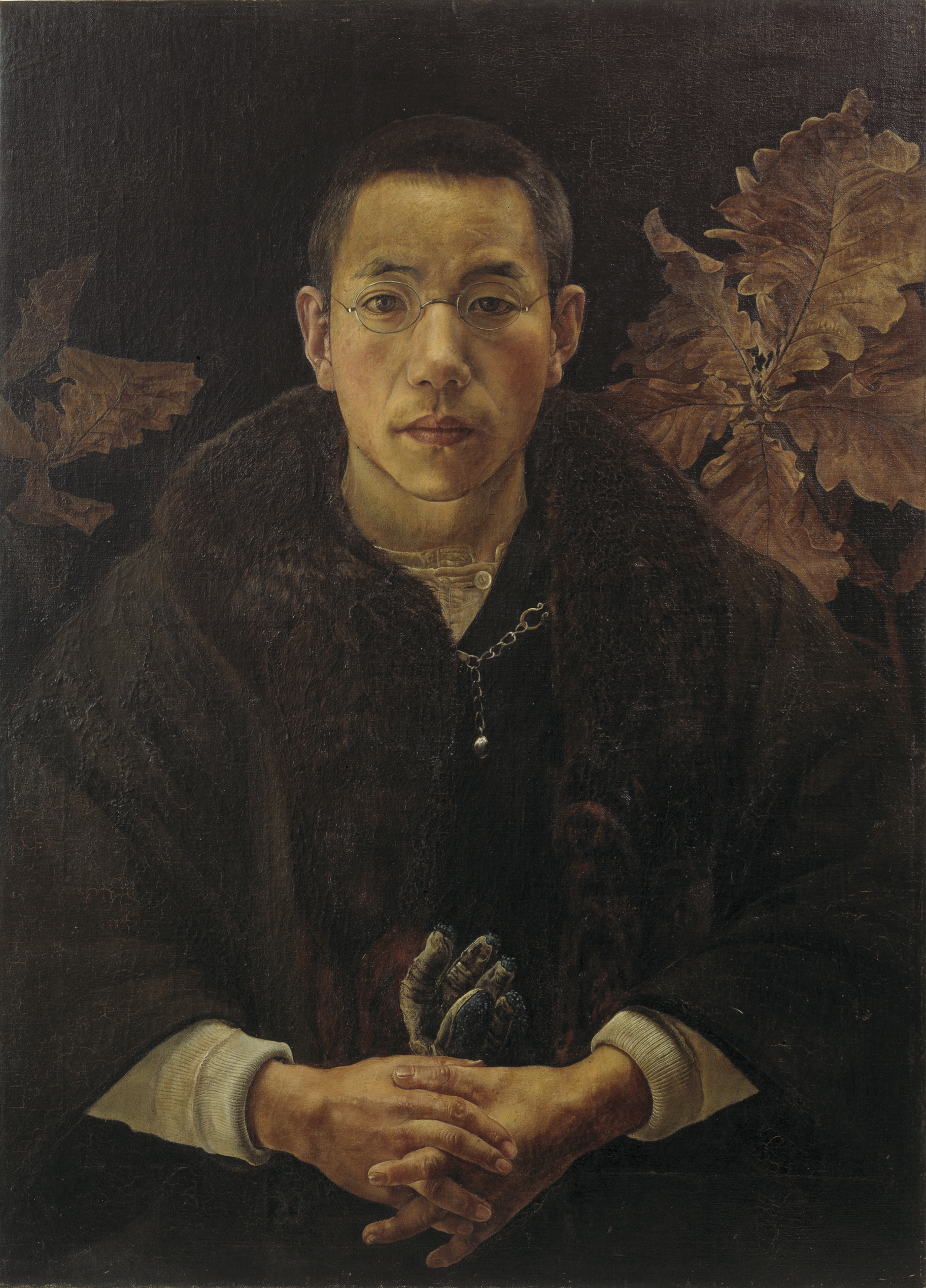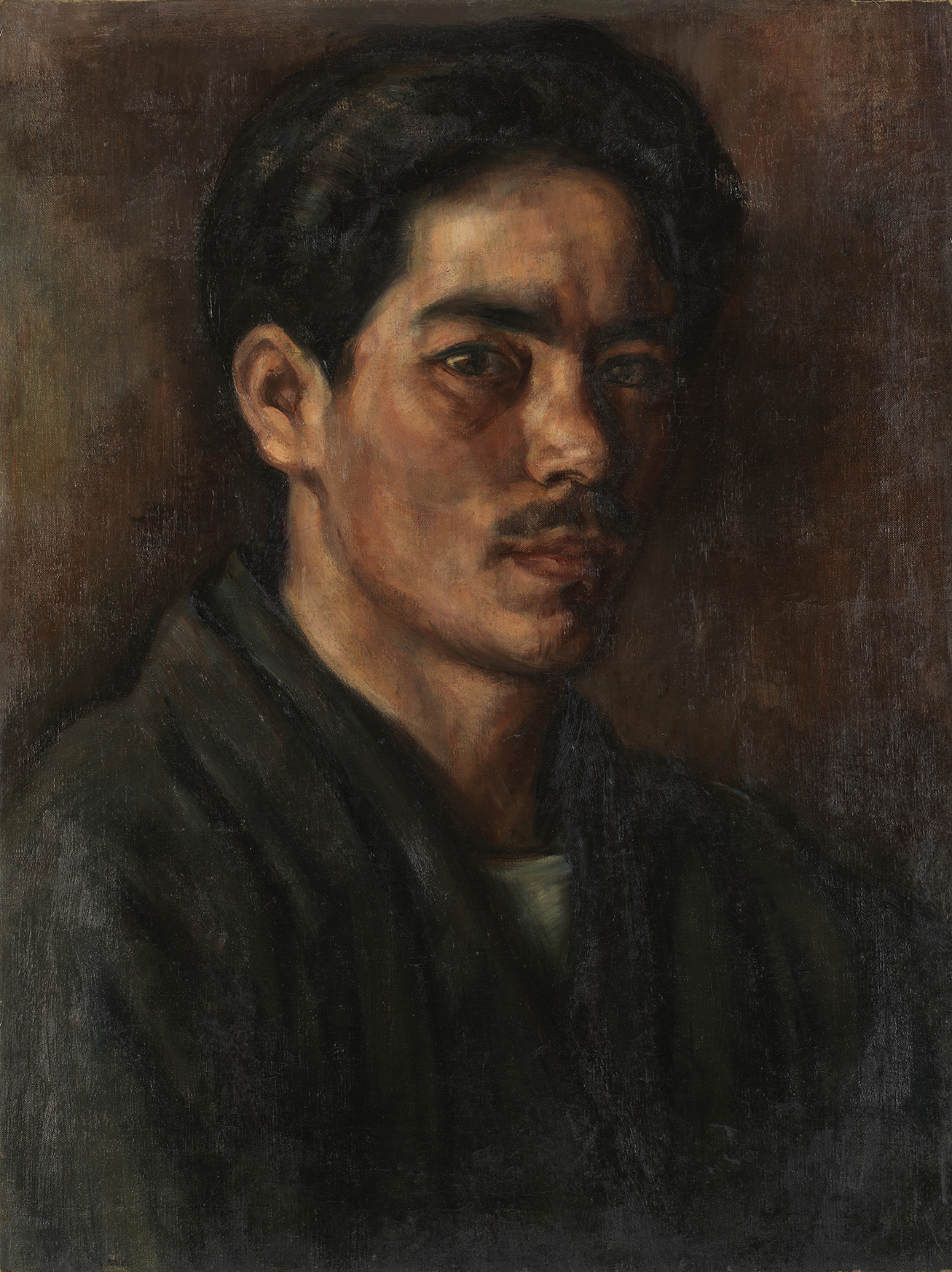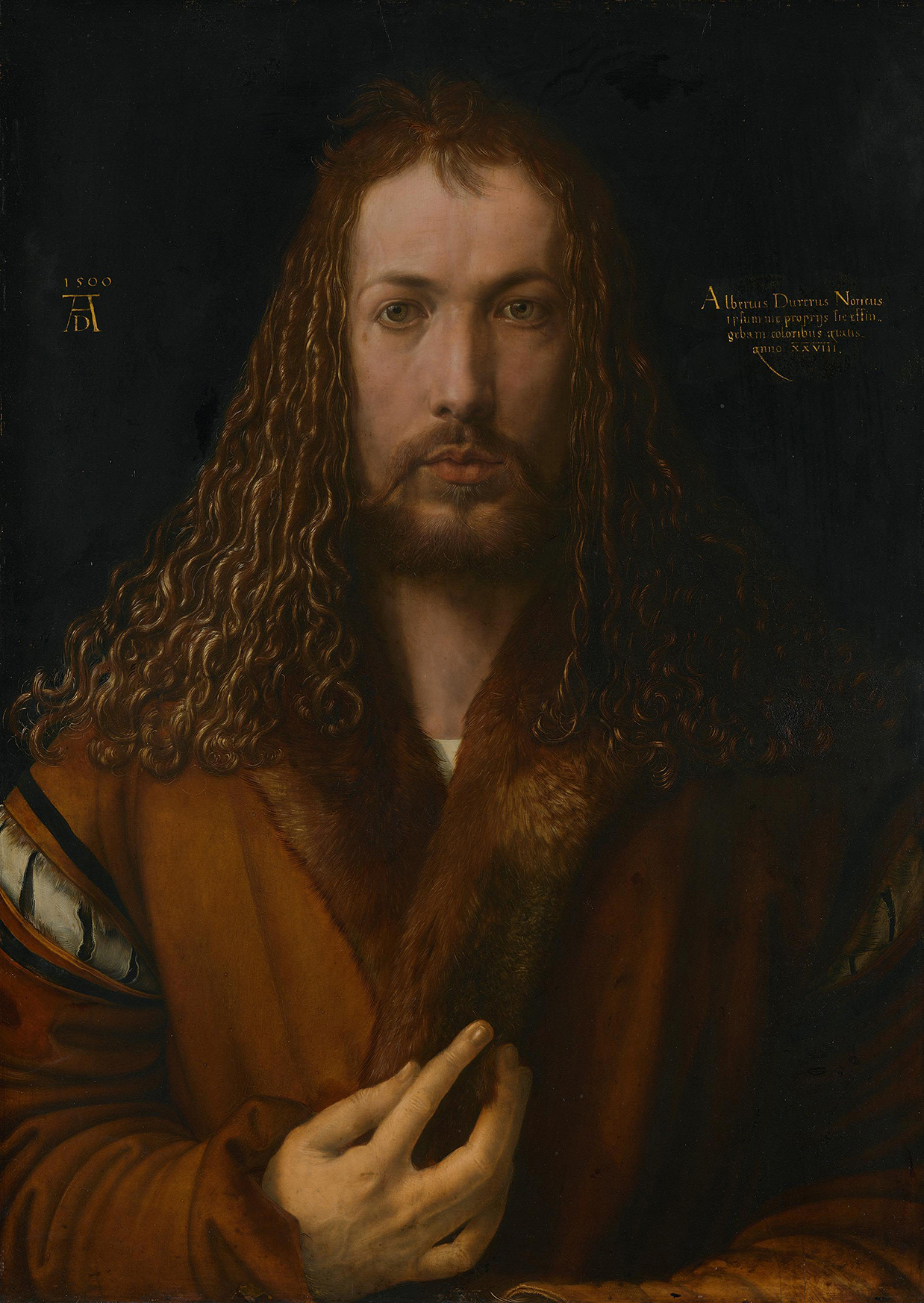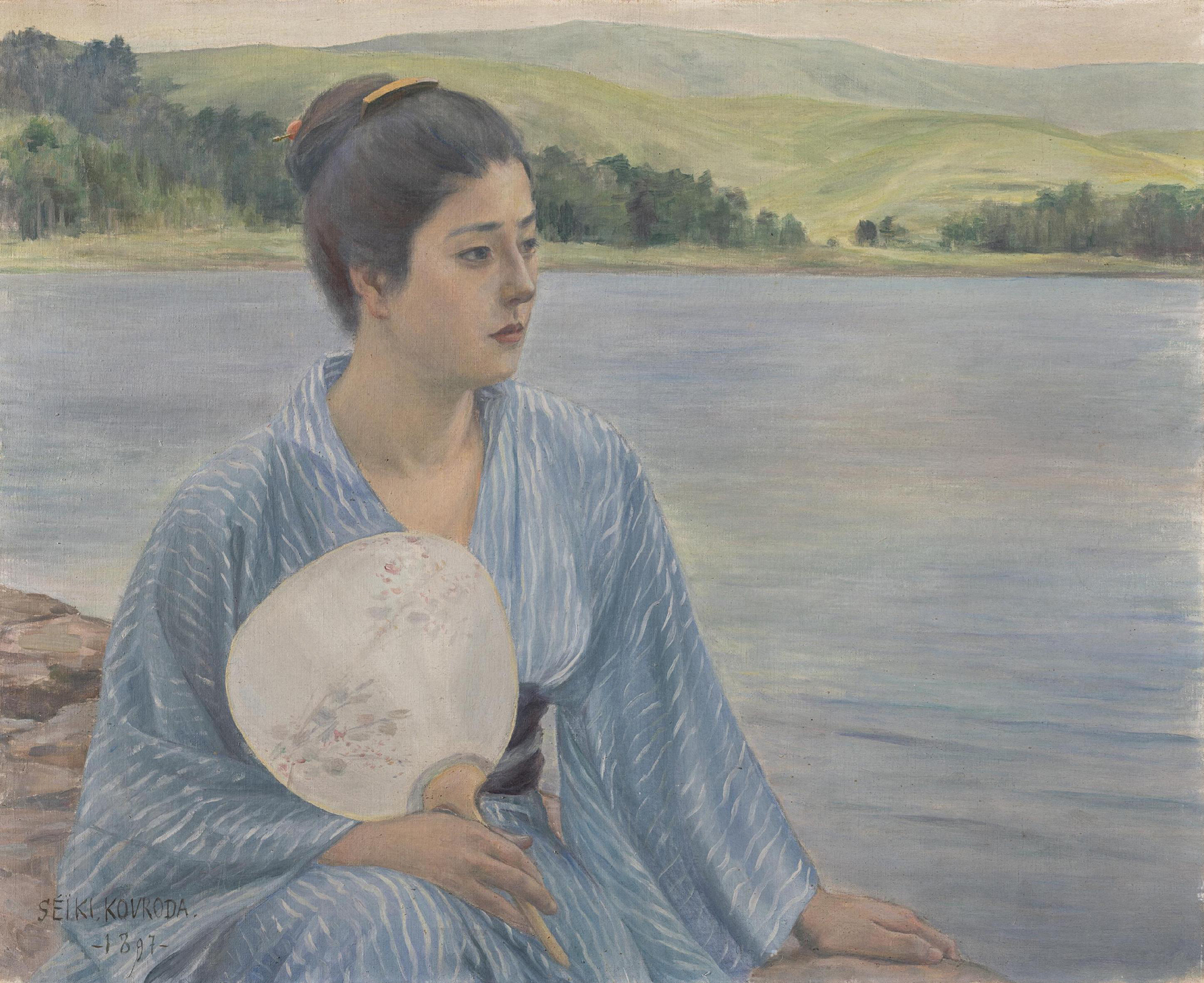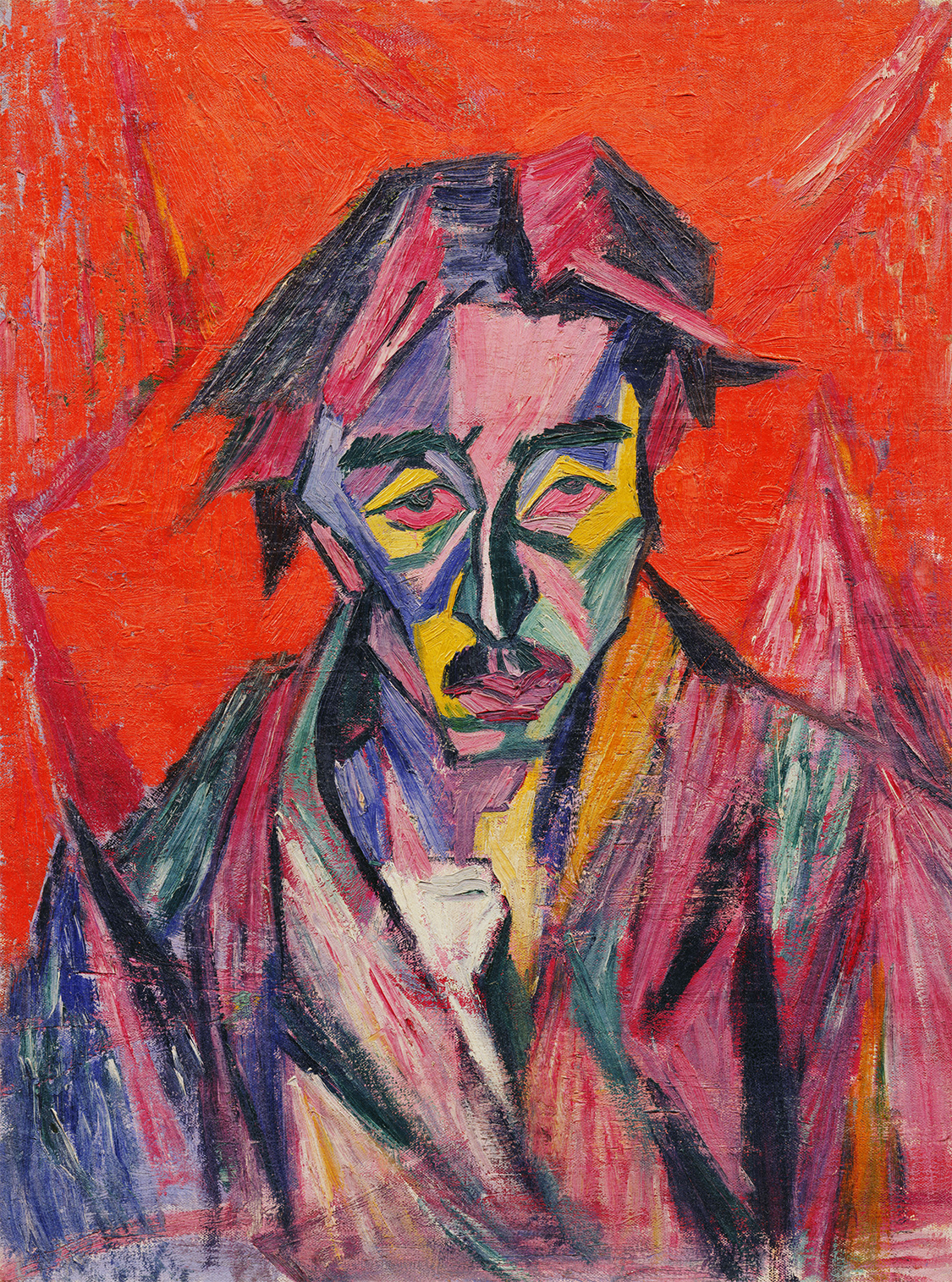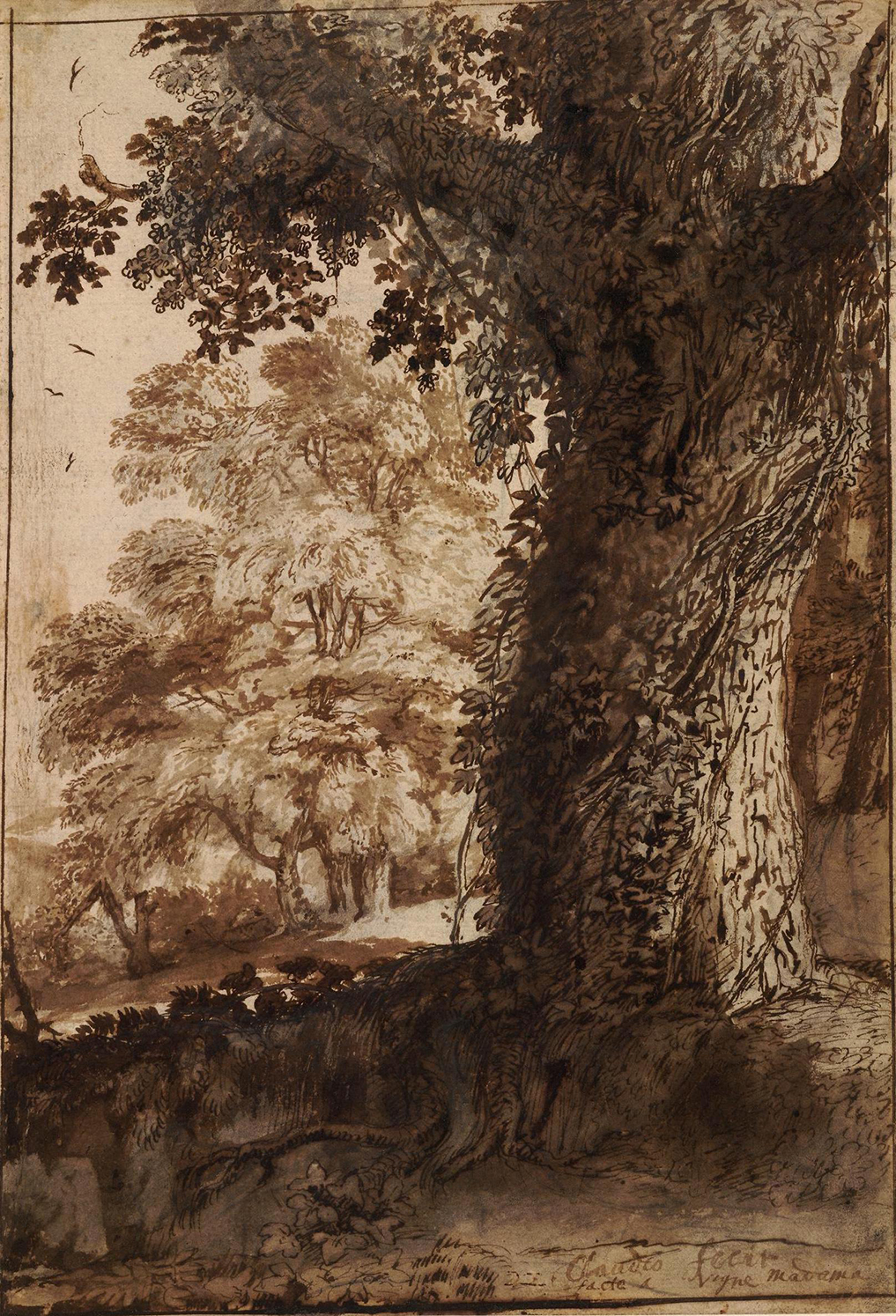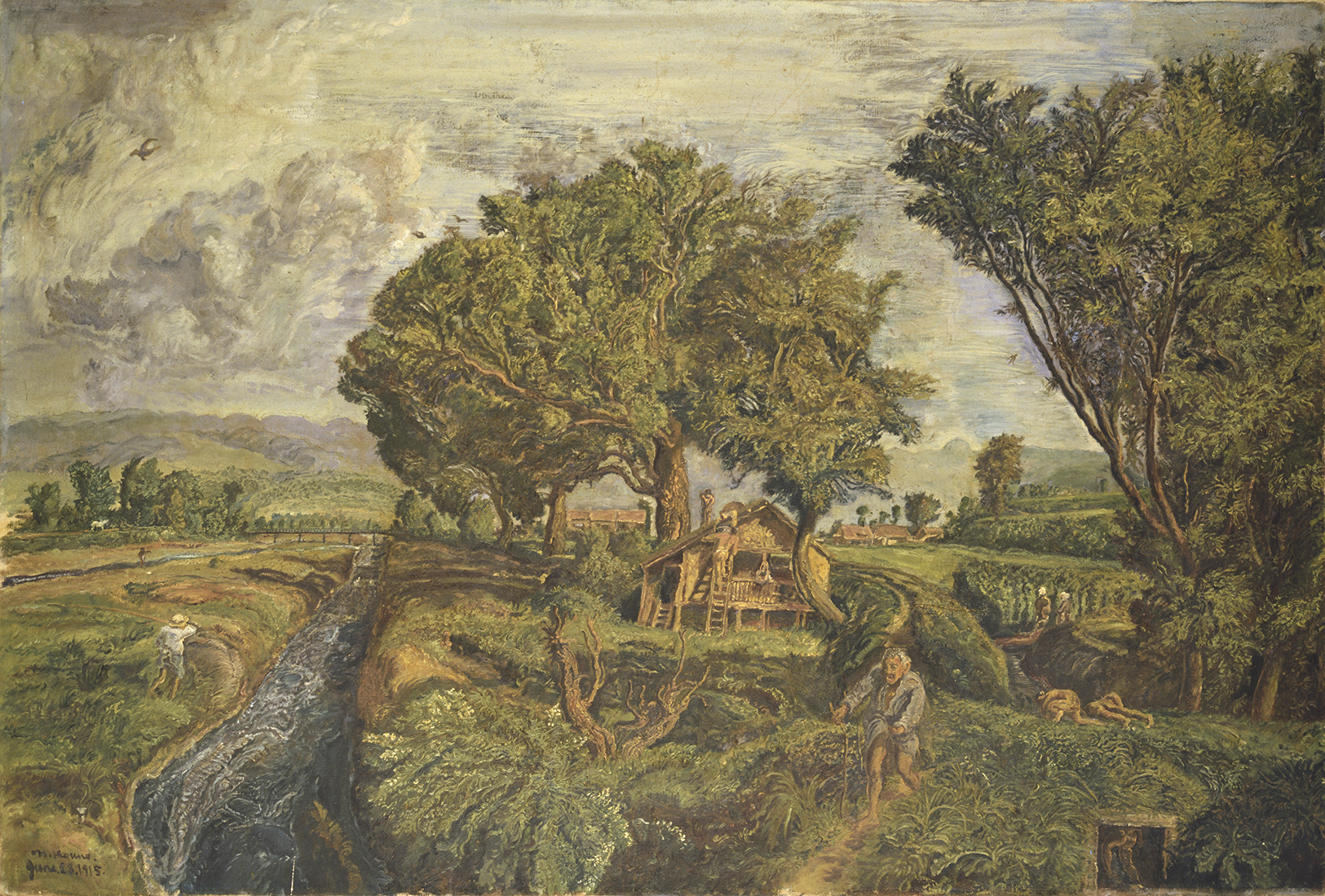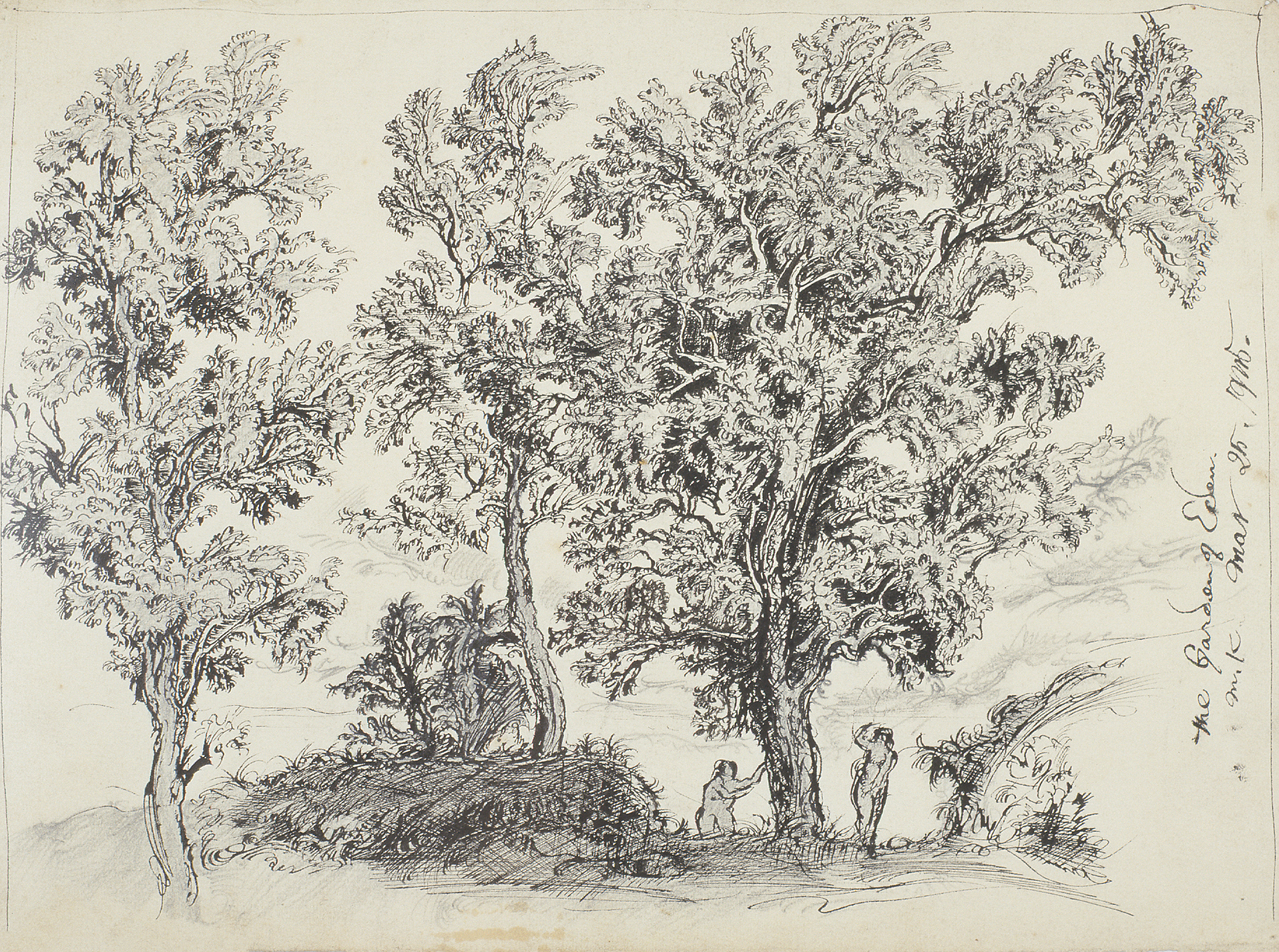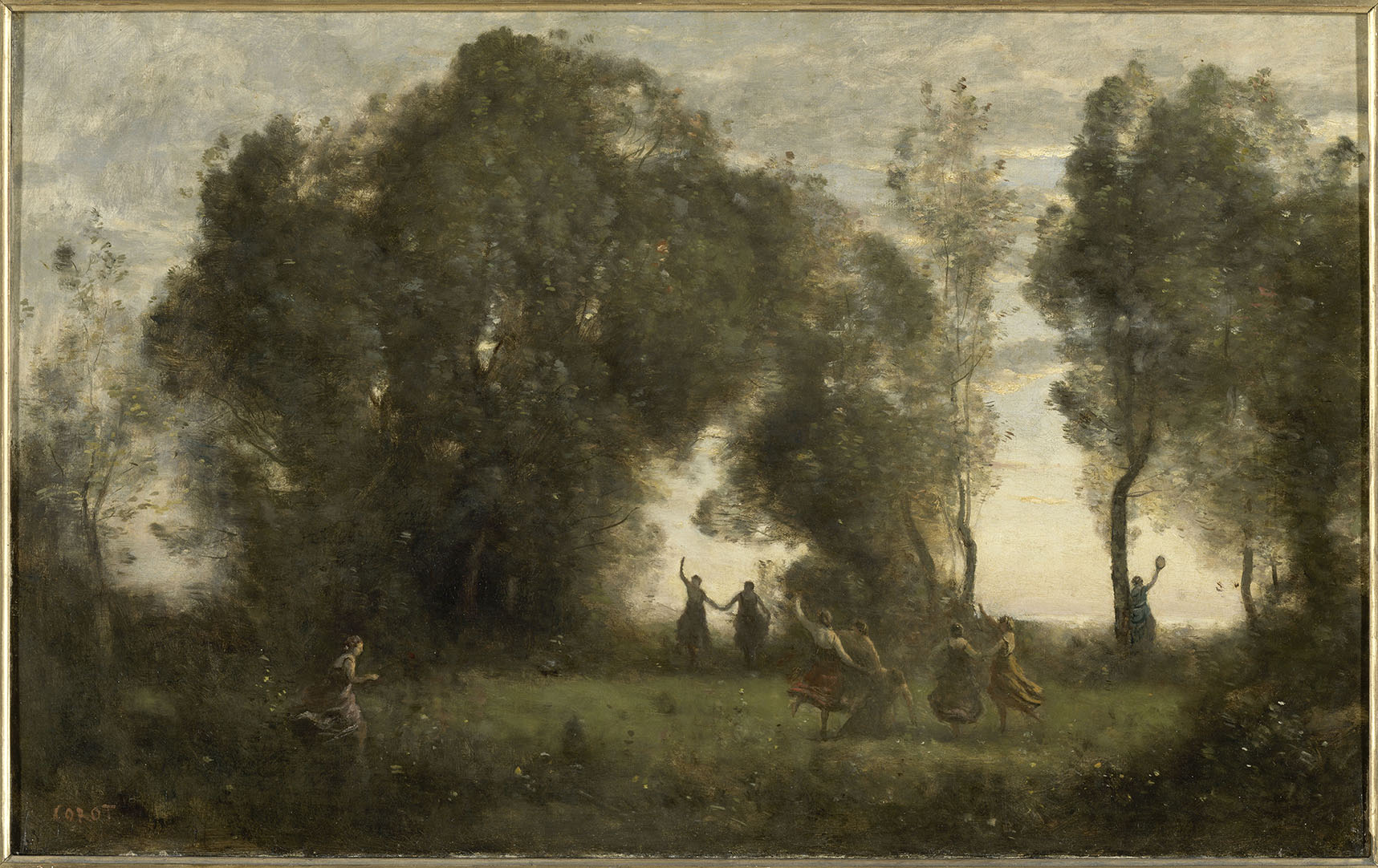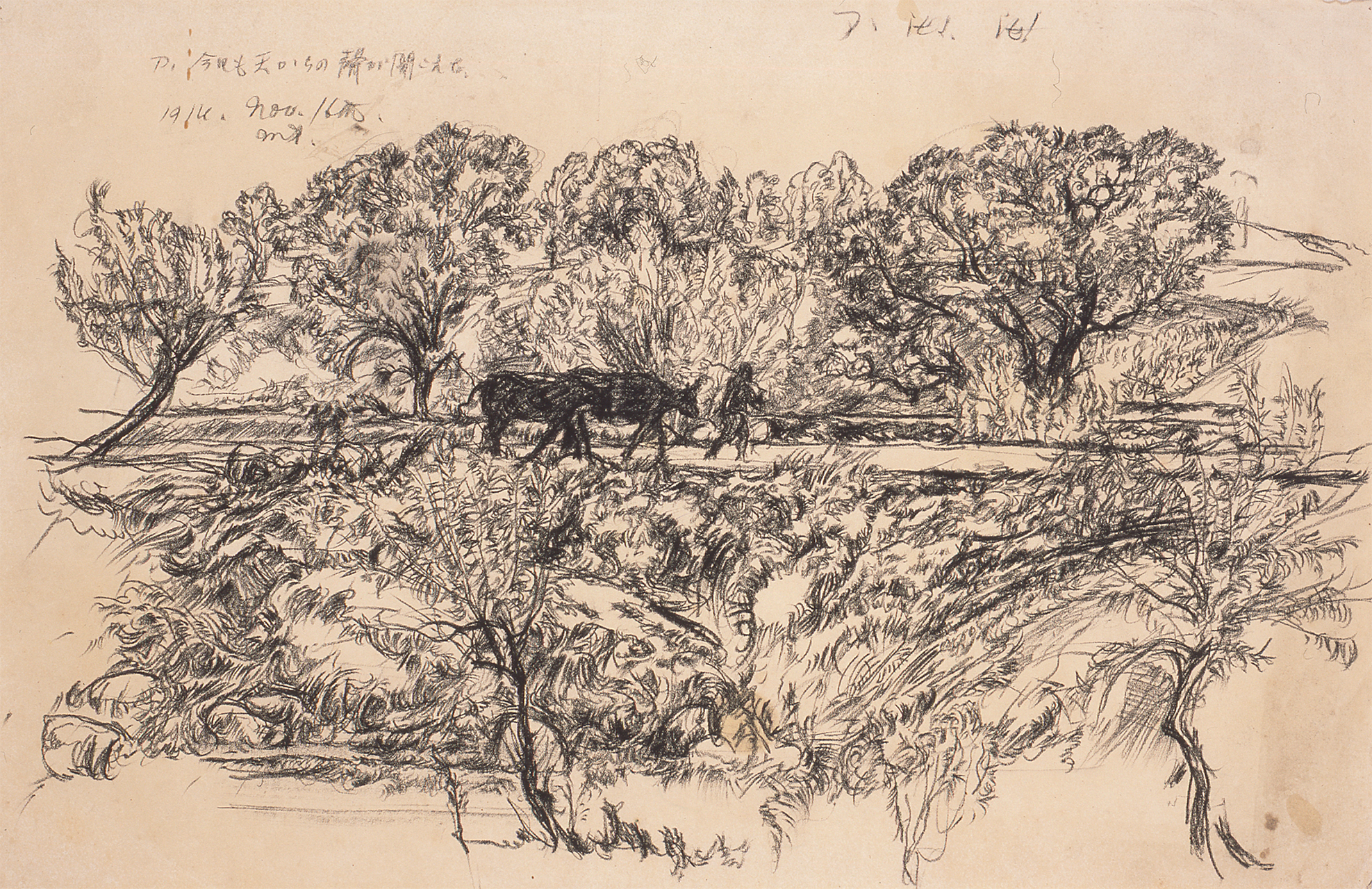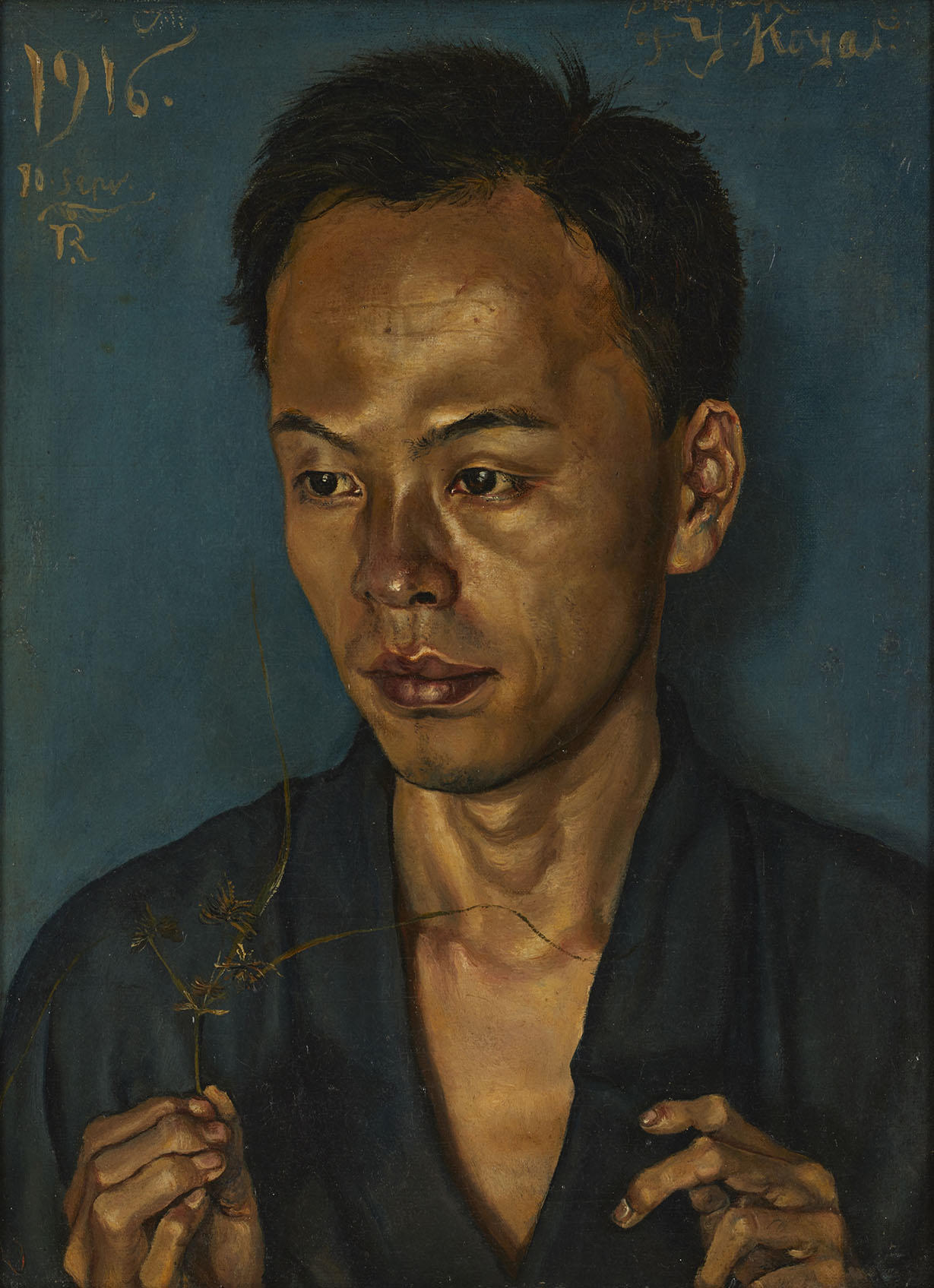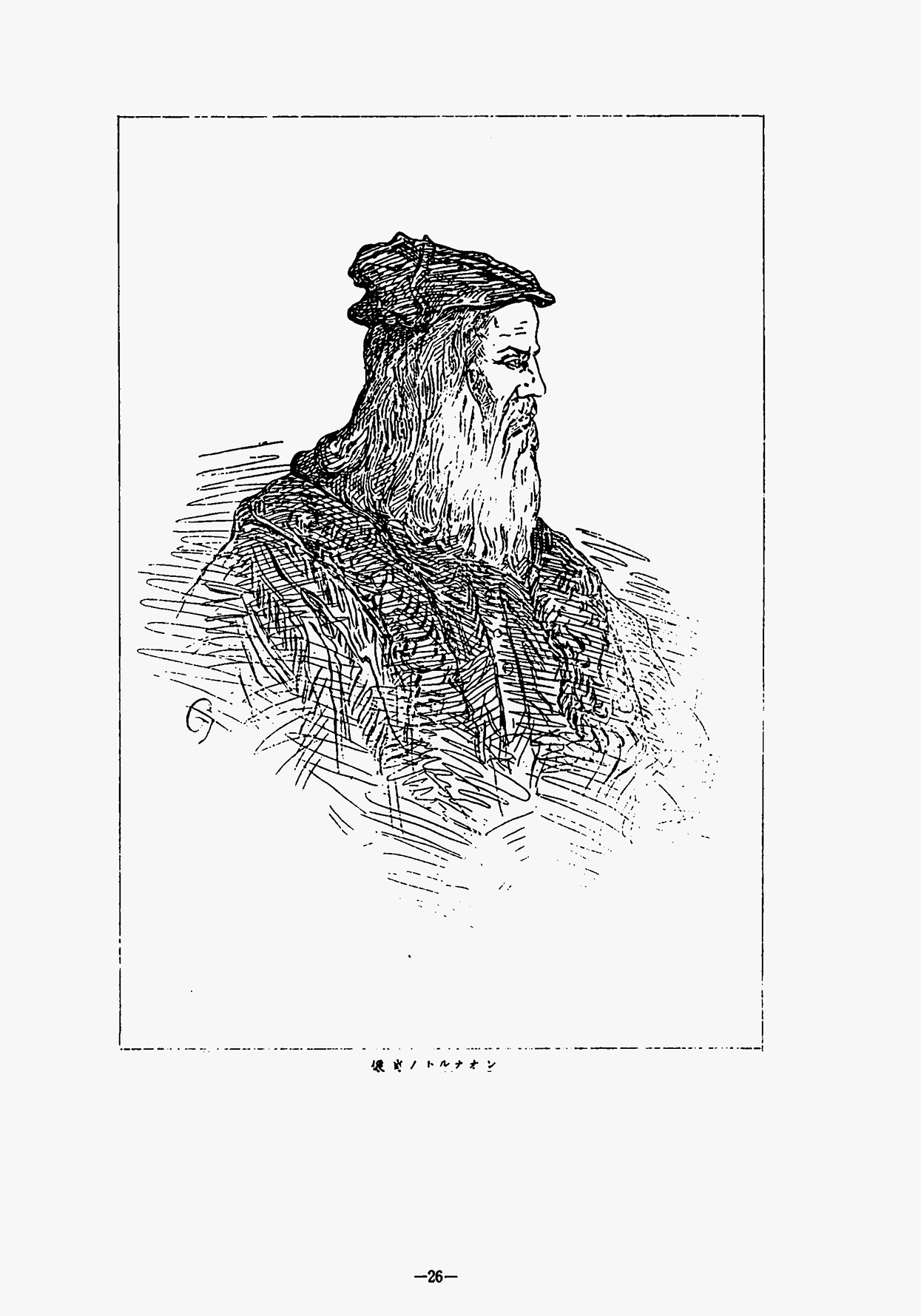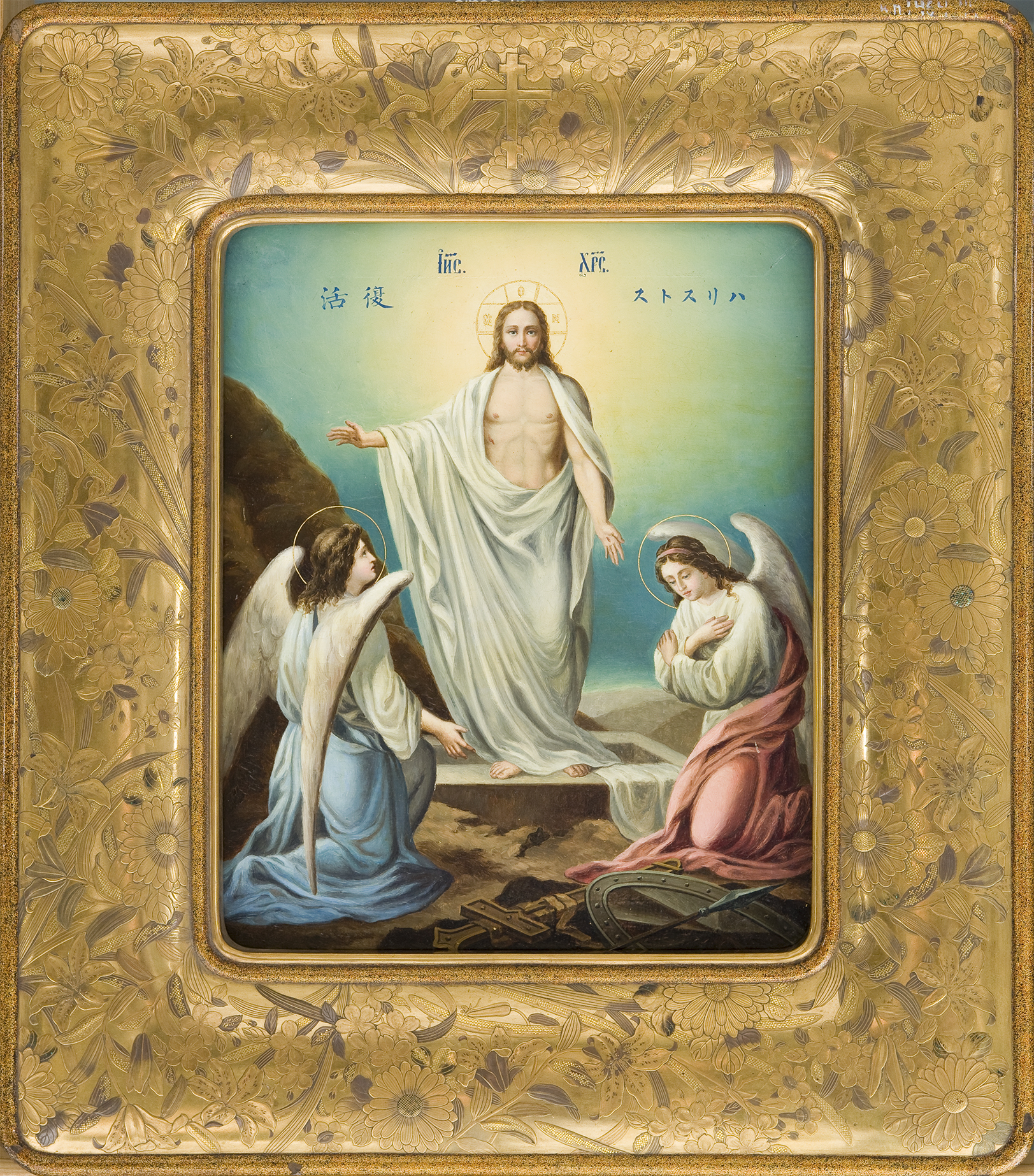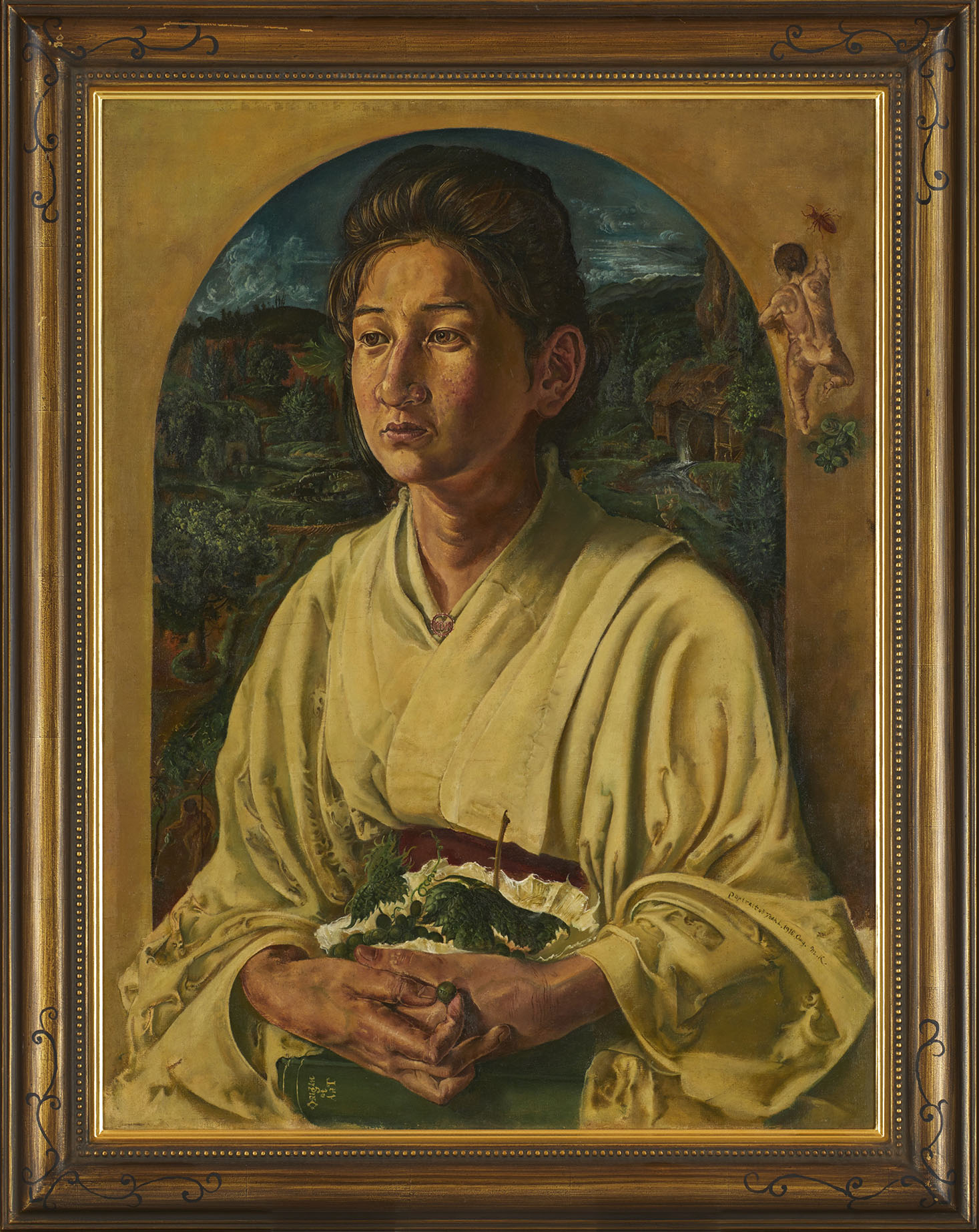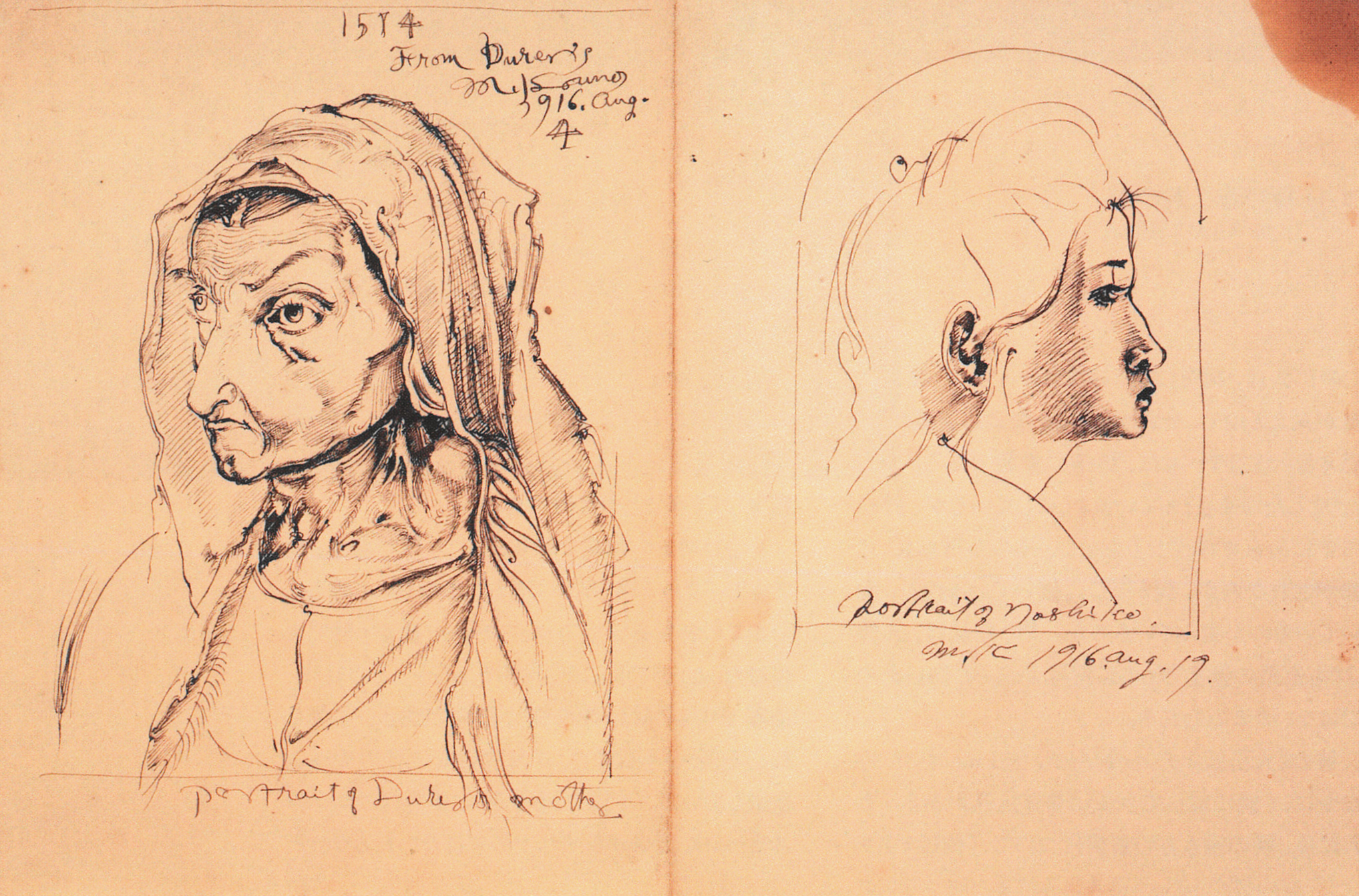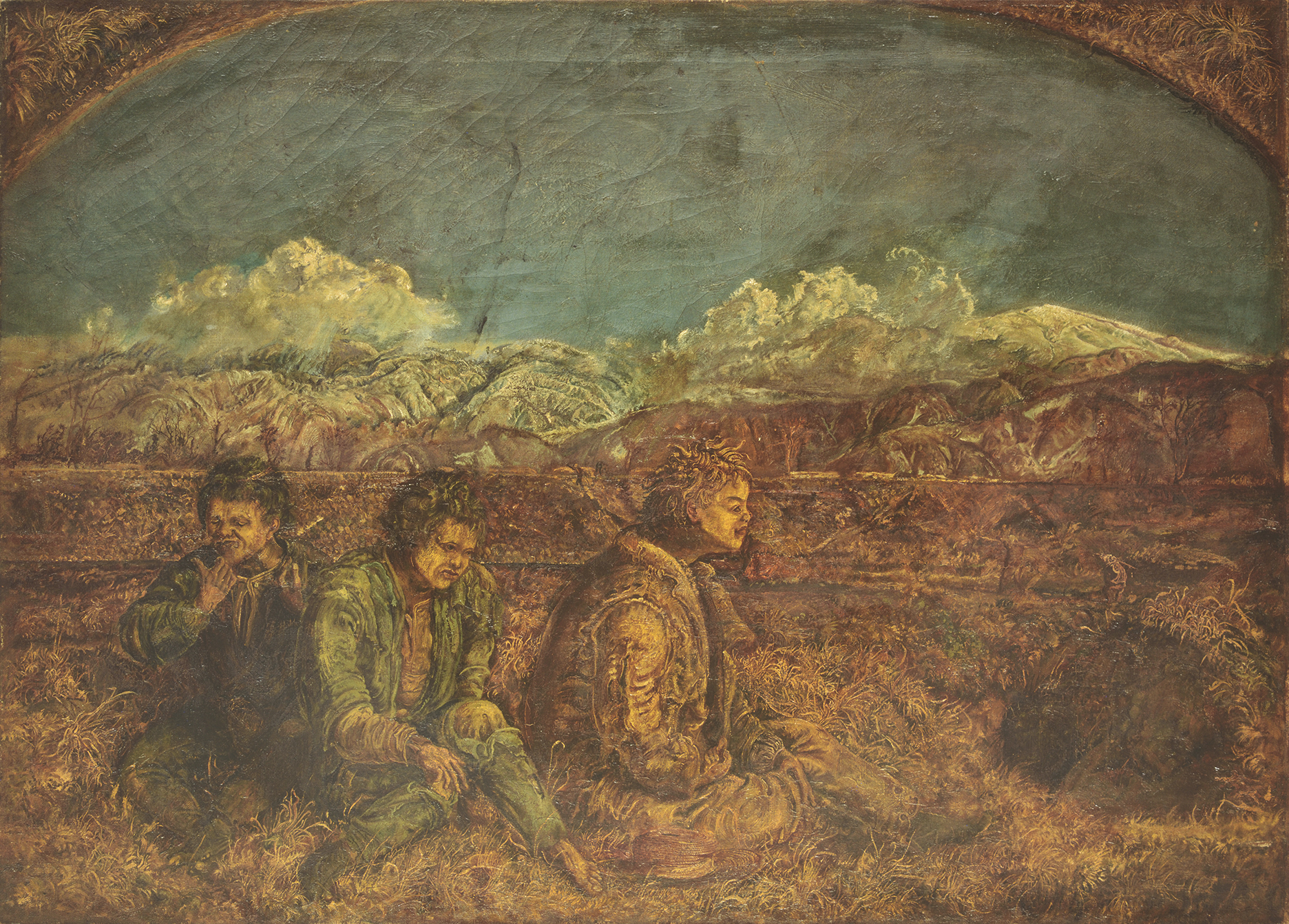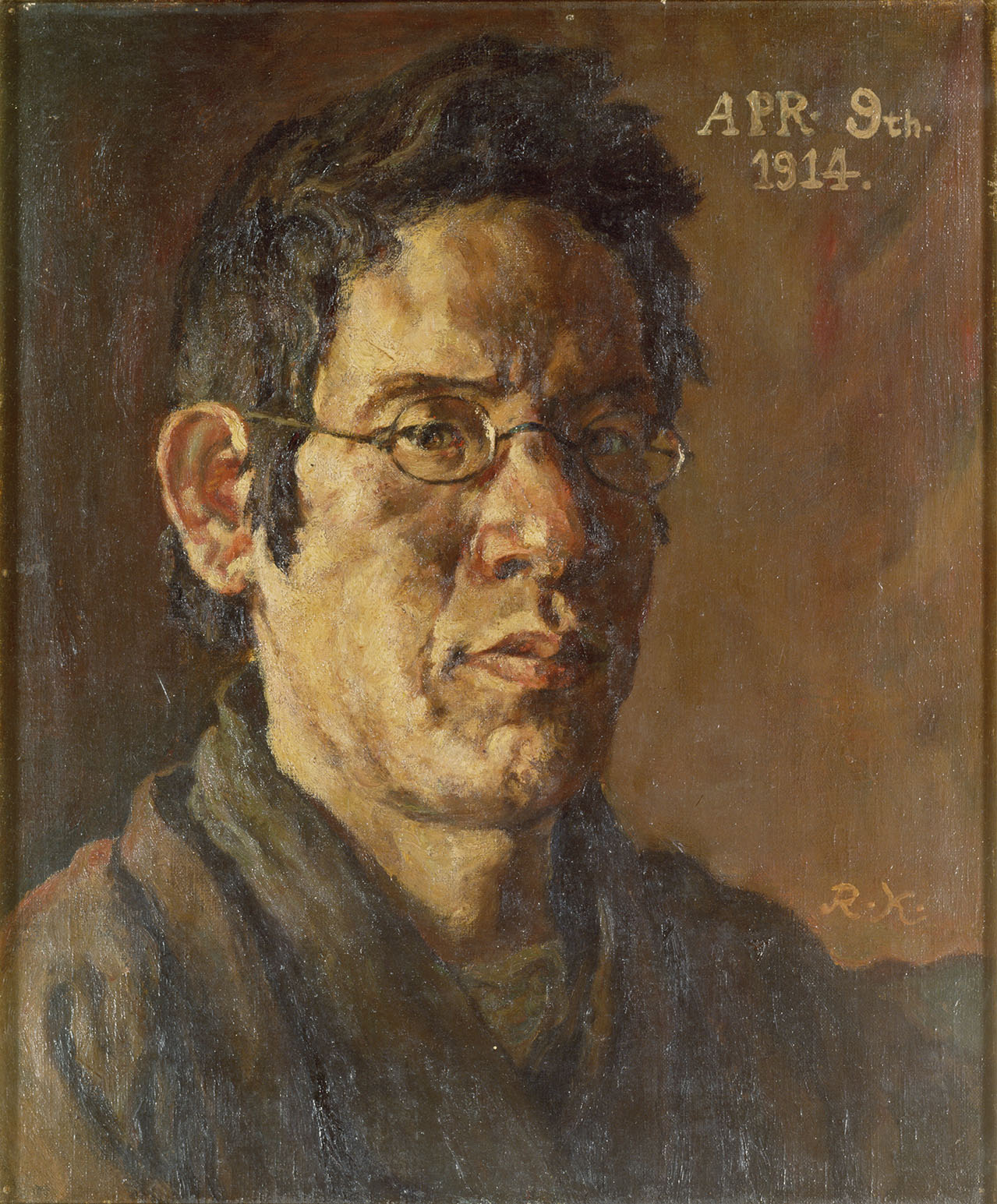Do not go toward Dürer’s light. I’m giving up my resolution to become the latest in a long line of torchbearers. I am not a torchbearer. Safely guided by Dürer’s light, it is my fate to build upon another rock.Kōno Michisei1
Bathed in a diffuse golden light and flanked by gargantuan oak leaves, Kōno Michisei 河野通勢 (1895–1950) calmly gazes out from behind silver-rimmed glasses in his 1917 Self-Portrait (fig. 1).2 The artist looks directly at the viewer, engaging them head on with his shoulders square to the canvas. Kōno’s expression is at once open but inscrutable, like the finely described but enigmatic objects with which he has surrounded himself. The heavy fur-trimmed robe around his shoulders, secured with a fine silver chain, is so meticulously rendered as to be palpable, and yet such patrician attire belongs to a time and place distant from Kōno’s native Japan. The single erect glove reaching skyward from beneath Kōno’s clasped hands poses a conceptual conundrum, seeming at once tangibly real in its detailed description but emphatically unreal in its autonomous animation. Finally, Self-Portrait reaches its most fantastic expression in the unnaturally overgrown cluster of oak leaves naturalistically rendered in the darkness behind Kōno’s left shoulder. Yet, for all these intriguing incongruities, when it was exhibited in Tokyo in 1917, Kōno’s self-portrait was lauded by contemporaries for nothing more than the artist’s superlative realism, which one critic described as evidence of the “flawless craftsman” (nanten mo naki sakunin 難点もなき作人).3
Exhibited at the state-sponsored annual salon, the Bunten 文展 (short for Monbushō bijutsu tenrankai 文部省美術展覧会), Self-Portrait was conceived to announce Kōno’s arrival onto the Tokyo art scene in virtuosic style. Kōno had periodically visited Tokyo to exhibit with independent artists’ societies since graduating from high school in 1914, but in 1917 he finally resolved to relocate to the capital from the rural suburbs of Nagano to begin his career. Self-Portrait was thus a coming-of-age piece akin to the serious self-portraits produced by students of the prestigious Tokyo School of Fine Arts (Tokyo bijutsu gakkō 東京美術学校) upon their graduation (fig. 2).4 Kōno’s decision to submit his self-portrait to the conservative state salon despite his history of exhibiting with reactionary avant-garde groups, including the Second Section Society (Nikakai 二科会), further suggests an intention to garner official recognition from the Taishō-period (1912–1926) fine arts institution, represented by the esteemed artists of the Bunten’s judging panel.5 While Kōno could not boast an artistic pedigree equal to the students of the Tokyo School of Fine Arts, his self-portrait was conceived to exhibit sufficient skill and learning to stand shoulder-to-shoulder with the work of his peers, and thereby proclaim his emergence as a professional artist.
Having successfully passed the Bunten’s discriminating panel, Kōno must have eagerly awaited the critics’ reception of his technically and conceptually ambitious piece. Not only had he exhibited his mastery of the realist techniques of European oil painting in Self-Portrait, but he had knowingly referenced its prestigious tradition by modeling his likeness on Albrecht Dürer’s (1471–1528) Self-Portrait with Fur-trimmed Robe (fig. 3). Contemporary critics were quick to acknowledge this aspect of Kōno’s painting, citing Hans Holbein (ca. 1497–1543) as well as Dürer as possible models for the painting’s dark palette and detailed realism. While Kōno’s ability to emulate the technically advanced oil painting of these European masters was widely admired, the potential intellectual and spiritual dimensions of Kōno’s appropriation of Dürer were completely overlooked and even denied.
Artist and critic Ōno Takanori’s 大野隆徳 (1886–1945) review of Kōno’s Self-Portrait for the journal Chūō bijutsu 中央美術 (Central art review) captures the prevailing spirit of contemporary art criticism:
This artwork is attracting crowds. . . . It is considered a great painting for its depiction of the small wrinkles of each hand and each and every eyelash; however, this artist seems to be ignorant of the joy of bright coloring discovered by recent artists. . . . Important qualities other than physical likeness, which pertain to the artist’s spirit, such as sentiment, impression, and thought, are absent. Even if the artist has expended great efforts to accomplish his work, this alone does not make it excellent. Aside from having a simple resemblance to the subject, the inclusion of the artist’s spiritual truth (seishinteki shinjitsu 精神的真実) is crucial to [the artwork’s] vitality. Without this, a work has no value. The strength of Kōno’s painting is the accuracy of his draftsmanship, which has the detail of a Holbein or Dürer. . . . However, beyond this, nowhere can the necessary expression of his artistic insight be seen.6
Fundamental shifts in the expectations of what and how a painting, in particular yōga 洋画 (Western-style painting), should communicate to viewers and the role of art in society over the previous decade lie at the heart of Ōno’s dissatisfaction with Kōno’s neo-Renaissance-style self-portrait. Yōga had fought a hard-won battle to be instituted as a leading form of painting alongside nihonga 日本画 (Japanese-style painting) in Meiji-period (1868–1912) Japan, having been regarded as a technically superior form of mimesis that was nonetheless inherently foreign and therefore detrimental to Japan’s cultural integrity.7 Advocates of yōga who had studied in Europe, like Kuroda Seiki 黒田清輝 (1866–1924), finally secured the status of Western-style painting by successfully harnessing it to Japan’s modern nation-building effort, establishing an educational curriculum modeled on the French academy at the Tokyo School of Fine Arts and an annual state-sponsored salon for the exhibition of the nation’s finest artworks. By the turn of the century, Western-style painting was finally a viable medium for Japanese artists, if only within the bounds of an elite, state-sponsored system.
Within a mere decade of yōga’s acceptance in official circles, however, its practitioners were again consumed with anxieties over legitimacy, form, and content. In pitting accurate draftsmanship and realism against the artist’s spirit and insight, Ōno’s review pinpoints the two most contentious issues facing yōga in the first quarter of the twentieth century, namely, the purpose of art and pictorial technique. While the Tokyo School of Fine Arts and the Bunten championed a national school of painting anchored in the naturalistic academic technique promoted by Kuroda and his colleagues (fig. 4), an increasing number of artists began to seek alternative modes of expression. Artists were not merely dissatisfied with the conservatism of the national school—they questioned the very tenets of yōga as a tool of state-sponsored modernism. What about art for the self? Since at least 1910, when the artist Takamura Kōtarō 高村光太郎 (1883–1956) published his seminal essay on artistic individuality, “Green Sun” (Midori iro no taiyō 緑色の太陽), ideas about painting as an authentic expression of the artist’s selfhood, as opposed to a convincing representation of nature or nation, had increasingly come to occupy the heart of critical discourse.8
By the time of Kōno’s Self-Portrait in 1917, the highly influential avant-garde artistic and literary coterie known as the White Birch Society (Shirakaba ha 白樺派) had enshrined self-expression, as epitomized by the oeuvres of modern masters including Vincent van Gogh (1853–1890) and Paul Cézanne (1839–1906), as the raison-d’être of contemporary painting, and while such progressive ideas began outside the academy, they soon infiltrated mainstream discourse. “The ultimate form of art is art for the Self. When art becomes the greatest attribute of the artist,” proclaimed the group’s spokesperson, Yanagi Sōetsu 柳宗悦 (1889–1961), “then it will deliver essential value and eternal life.”9 Young yōga artists skeptical of the government’s hegemony over painting willingly embraced this credo, but the problem of defining a self in modern Japanese society and using an essentially foreign medium to express this selfhood created what Erin Schoneveld has termed a “burden of originality” for Japan’s second generation of modern artists.10 The expressionist paintings of the European avant-garde circulated in coterie magazines like the White Birch Society’s eponymous publication lit a path to artistic originality and self-expression for many, and yet to follow European precedent too closely risked accusations of artifice and imitation.
Self-portraiture in particular played a significant role in this newfound quest to discover and affirm an authentic self in painting. Artists’ growing awareness of their social status in Meiji Japan helped popularize what had once been a minor genre in Japanese art. Having been instituted as an integral part of the Western-style painting curriculum at the Tokyo School of Fine Arts, the genre was ripe for experimentation as artists sought to wrest yōga from the state and make art for the self. Indeed, no other genre more forcefully embodied artists’ growing conviction that oil painting should convey the spirit of its maker. Far from the dark realism of Kōno’s Northern Renaissance–inspired self-portrait, however, most Taishō artists adopted the bright palette and expressive distortions of the Post-Impressionists to articulate what Yanagi had termed their unique “experience of existence” (jitsuzai keiken 実在経験).11 Yorozu Testugorō’s 萬鉄五郎 (1885–1927) Self-Portrait with Red Eyes (fig. 5), for example, reflects how Kōno’s contemporaries experimented with the latest techniques being introduced from Europe via print media to manifest a tortured pursuit of self-representation in a society dominated by government ideology.12
For the White Birch Society and its subscribers, naturalistic expression was anathema to the modern artist’s mission—not only was it associated with the conservatism of the fine arts institution, but it subsumed the artist’s free will to an “objective” reality, thus fettering authentic expression. As such, it was precisely Kōno’s meticulous technique and fidelity to nature that for many hindered the necessary expression of the artist’s “spiritual truth.” In stark contrast to Yorozu’s gestural brushstrokes and evocative colors, Kōno’s finely finished painting was seemingly mute. Even for those who could appreciate his allusion to Dürer’s self-portrait, anxieties over the derivativeness of contemporary oil painting prevailed, and discussion focused on whether Kōno had succeeded in demonstrating more than a superficial appreciation of the art of the Northern Renaissance, with one critic opining that it would be preferable “to see a greater acquaintance with and admiration for the feel of that age” in the painting.13 Such issues forestalled consideration of the symbolic import of Kōno’s anachronistic choice of painterly mode or his imaginative rephrasing of Dürer’s iconic visual rhetoric.
Since being gifted to the Smithsonian’s National Museum of Asian Art by Kōno’s son, Kōno Shuntatsu, in 1998, art historians in Japan and the United States have reappraised Self-Portrait, and it is now recognized as a masterpiece of both the artist’s oeuvre and Taishō-period Western-style painting. Scholars have done much to begin unraveling the mysteries inherent in the painting’s facture and iconography, with Kōno’s decision to consciously model himself on Dürer’s Christ-like self-portrait drawing the most attention.14 In his assessment of Self-Portrait, for example, Bert Winther-Tamaki credits Kōno with realizing the self-aggrandizing potential of Dürer’s model, which his more famous contemporary and close friend Kishida Ryūsei 岸田劉生 (1891–1929) had failed to do in his own self-portraiture. In the Dürer-esque self-portrait, Winther-Tamaki argues, Kōno succeeds in achieving a grandiose ambition to project personal and political power through painting.15
Ejiri Kiyoshi alternatively describes Kōno’s interest in Northern Renaissance art and Dürer’s painting as stemming from his perception of its organic spiritual quality, which was familiar to him through an upbringing in the Christian church. In that light, Ejiri concludes that, inspired by Dürer’s Christo-morphic self-portrait, Kōno’s Self-Portrait “is painted from directly in front of the artist to bring out the divinity from within [himself].”16 Ejiri also interprets the preternatural oak leaves behind Kōno as a manifestation of his daemon, a supernatural creative spirit that originated in the sublime landscape of his native Nagano and pursued him, menacingly, to Tokyo.17
The reception of Kōno’s Self-Portrait has transformed over time, from a discourse centered on the relative merit of its consummate verisimilitude to a more pointed analysis of its embedded symbolism and indebtedness to Dürer. An in-depth consideration of the significant idiosyncrasies of the work, which point to his personal struggle to address the most pressing artistic issues of the day, remains lacking, however. Kōno’s painting of his self is perpetually interpreted relative to others—to nature, to Dürer, and to Kishida, who casts a lengthy shadow over the younger artist’s achievements. In this essay, Kōno will be recentered. Kōno’s self-portrait operates within multiple artistic traditions, from Taishō-period individualism to Northern Renaissance realism, but these variously intersect with and are molded by the artist’s own highly personal worldview, his “experience of existence.” Kōno’s first attempt to represent himself in the Tokyo art world in 1917 was forcefully shaped by his unique conception of art history, nature, and self at the periphery of the art world in Nagano, and thus, it is by first revisiting these formative years and his unorthodox artistic education that we can begin to deconstruct the enigma of Self-Portrait.
Of Books, Trees, and Leaves: The Nagano Landscape
Kōno’s introduction to painting was highly informal despite the professional ties of his father, Kōno Jirō 河野次郎 (1856–1934), to the art world as an artist and teacher trained under yōga pioneer Takahashi Yuichi 高橋由一 (1828–1894).18 Surrounded by his father’s extensive library of art books, journals, and prints, rather than receiving direct instruction from his father, Kōno curated his own artistic experience as a child and developed an intimate relationship with the old masters, whose work he admired and copied from Western art survey books. In later years, Kōno vividly recalled the strong smell of this “mountain” of art books, which he described as being “inseparable from happy recollections of my childhood.”19
Kōno’s encounter with the Western canon, like that of many of his contemporaries, was mediated and shaped by print. While yōga students at the Tokyo School of Fine Arts, under the aegis of powerful institutional figures, received private funding or government stipends to study in Europe, artists outside the academy relied on illustrated books and magazines for precious glimpses of European painting. Despite the obvious limitations of this vicarious education, Kōno benefited from the freedom it afforded him to peruse the canon at will, unimpeded by institutional doctrines regarding school, style, or nationality. Kōno’s engagement with the tide of imagery entering Japan from Europe at this time via his father’s library was further liberated by his lack of formal pedagogical structure and relative distance from the hubbub of the Tokyo art world, and thus the young artist’s willful imagination organically integrated images of canonical artworks into a highly personal curriculum.
Kōno’s artistic education was the product of a symbiosis between his father’s books and the local landscape in which he spent his youth playing with friends and sketching. Kōno was as much drawn to nature as to painting—if not more so—and his desire to capture the beloved environs of the nearby Susobana River directed and inspired his ceaseless study of the Western masters, who furnished him with a range of lenses through which to understand and describe the natural world. Kōno’s middle-school diary and artworks document his unique artistic formation between the Nagano countryside and European landscapists as he sought to master the depiction of the willow trees he encountered daily by the river. At this time, among the many artists studied by Kōno, from Rubens (1577–1640) to Rembrandt (1606–1669), Claude Lorrain (1600–1682) captured the student’s imagination for his depiction of mighty oaks (see, for example, fig. 6). Such was Kōno’s fascination with these trees and their potential to aid his expression of the Susobana willows that he dedicated weeks to detailed studies of Lorrain’s “Oak tree in winter,” spending at least thirty minutes on the careful reproduction of each branch.20
Kōno’s innumerable sketches and paintings of the willows that populated the banks of the Susobana River reveal how he synthesized the stylistic models he studied in his father’s books to create idiosyncratic, visionary interpretations of the local landscape. Kōno had traveled far from the antique serenity of Claude Lorrain by 1915 with his Susobana River Willows (fig. 7), which is alive with the writhing lines of blustery clouds and bushy trees. While Susobana River Willows borrows something of the earthy color and picturesque composition of the John Constable (1776–1837) landscapes the young artist studied, its expressive line, full of pulsating vitality, and the playful narratives suggested by the mysterious figures scattered throughout the landscape are Kōno’s own.
For Kōno, the boundary between the mythical, foreign landscapes he experienced vicariously in print and the real landscape on his doorstep was highly porous, resulting in almost febrile visions of the Nagano countryside playing host to ethereal nudes and biblical figures (fig. 8). While he imagined the Susobana willows as the real-world locus of the nymphs he encountered in Jean-Baptiste-Camille Corot’s (1796–1875) Dance of the Nymphs (fig. 9),21 his imaginative engagement with the Claude Lorrain landscapes he copied when fifteen transformed Lorrain’s quiescent pastoral scenes into alien worlds filled with impossibly tangled, elongated trees familiar only to the young Kōno.22
As a student of art, Kōno’s highest ideal was not the accurate imitation of the canonical works he studied in books but the compelling depiction of the natural world around him, in particular, trees. While copying Lorrain’s oak trees, Kōno spent his evenings reading about the botany of trees to augment his depictions, and by 1916 he proudly noted in his diary that “my knowledge of trees is second to none, past or present. It’s unapparelled. Unparalleled. Truly!”23 Trees were firmly planted at the center of Kōno’s worldview as a child. Trees both inspired his art and channeled his nascent Christian faith as a junior member of the Russian Orthodox Church (Nihon harisutosu seikyōkai 日本ハリストス正教会) in Nagano. According to his father’s wishes, Kōno was baptized at the local church at the age of nine and spent his childhood in a small but diverse Christian community populated by Methodists and Anglicans as well as Orthodox devotees.24
Annotations on Kōno’s landscape sketches hint at how Christianity nurtured his innately profound connection to nature, giving his work to capture the landscape around him a sense of divine purpose. In a sketch dated November 16, 1914, in the sky above a wooded rural scene he recorded a divine intervention in his work: “Ah, also today I can hear a voice from the heavens. Thou! Thou!” (fig. 10). Kōno would later recall that in his youth he believed that to paint trees was a mission handed down to him by God.25 The vitality of his landscapes from this time suggests that Kōno attributed a kind of powerful autonomous spirit to natural phenomena, and thus his brush imbues trees with a life-force typically reserved for humanity alone. As Ejiri Kiyoshi notes, there is an animistic spirit typical of Japanese Shintoism in Kōno’s painting that did not conflict with his Christianity, but rather, due to the Russian Orthodox Church’s relative tolerance for divergent indigenous beliefs, enriched his devotional practice.26 Kōno’s art was thus born of a syncretism unique to the artist in which art history, nature, and faith directed his hand and molded his burgeoning sense of self.
While as a child Kōno saw trees as endowed with a divine spirit and playing host to Corot’s nymphs, as he matured Kōno regarded trees as a locus of artistic virtuosity redolent of the painter’s unique character. “Every first-rate artist,” he argued, “has an ideal when it comes to trees. It is true of Corot and true of Constable.”27 One of Kōno’s favorite passages from John Charles Van Dyke’s (1856–1932) published lectures, The Meaning of Pictures (1903), which he read in Japanese translation, tied the painting of trees to artistic individuality, suggesting how the young artist came to include an arboreal attribute, oak leaves, in his Self-Portrait. Kōno was inspired by Van Dyke’s assertion that “if three painters, say Turner, Rousseau, and Claude Monet, could be brought together and induced, each for himself to paint a given tree … each would differ from the other and yet no one of them [would] be false.”28 The painter’s power to determine the character of the tree in a painting, argued Van Dyke, in turn requires that the tree “exhibit what we have called [the artist’s] individuality.”29 This statement is borne out not only in Kōno’s adolescent manifestations of the Nagano landscape, but in the giant clusters of golden oak leaves positioned behind the artist in his 1917 Self-Portrait.
Circumscribed in a more subdued iteration of Kōno’s characteristic writhing line, the larger-than-life oak leaves in Self-Portrait exude a preternatural vitality commensurate with the artist’s deeply spiritual connection with nature. While a cluster behind the artist’s right shoulder seems to shrink and recede into the darkness, another larger cluster rises up to his left. Kōno’s inclusion of oak leaves in this inaugural self-portrait was natural for an artist whose sense of self and the world had been mediated by trees, but immersed in anxieties about his future, Kōno confessed a fearful ambivalence toward his arboreal muse:
Here’s the thing. I can paint anything and I feel empowered. First of all, I studied trees, but later, I became consumed with the idea that it was my unique mission to paint trees. . . . That was my trick, my method. I completely lost my way. I must not lose my senses or principles on this path. I must not lose sight of my goal. I must not stray from my true path. It seems there is an open path ahead, but, in truth, it’s a labyrinth.30
Ejiri Kiyoshi notes the tension between Kōno’s seeming desire to manifest his own spirit and personhood through conscious reference to Dürer’s Christo-morphic image in Self-Portrait with Fur-trimmed Robe and the vital presence of the oak leaves, which he interprets as the manifestation of Kōno’s subconscious inner daemon. Noting the potential for the strangely animate oak leaves to either protect or threaten the young artist, Ejiri concludes that, “although some time has passed since he left Nagano, [Kōno] cannot escape the call of his daemon.”31 However, while the largest cluster of daemonic oak leaves rears up behind Kōno, he calmly looks ahead, seemingly unaware of its presence, ignoring its call to follow a seductive labyrinthine path. While the centripetal arrangement of the leaves and their curling edges suggest a primeval life-force within, the leaves’ golden and dessicated appearance reveal a vitality that is waning, or rather, subdued.
Kōno’s curling oak leaves mark a distinct departure from the vegetal motifs seen in the more famous Renaissance-inspired portraits of Kishida Ryūsei, with whom Kōno was acquainted by this time.32 Kōno’s senior by four years, Kishida was an active figure in avant-garde circles in Tokyo and leader of the Grass and Earth Society (Sōdosha 草土社). Having experimented with Post-Impressionism in his early career, Kishida turned to a form of meticulous realism based on Dürer to better express his vision of the world, and from 1915 he produced a number of portraits in this mode, often featuring floral attributes. In Portrait of Koya Yoshio (fig. 11), for example, Koya holds a stem of wild grasses that extends from the tips of his fingers and reaches delicate tendrils toward his face, as if they are growing toward its luminescence.
Like Kōno, Kishida had been touched by Christianity in his youth, and while his faith was less devout he maintained a positive view of nature as a divine gift to be protected and cherished. Nature was thus an indispensable part of Kishida’s project to “paint the portrait of humankind,” and floral motifs in his work, like the grasses in Koya’s portrait, have been understood as symbols of life’s vitality and humans’ affinity with God’s creation.33 This is not quite the nature that appears in Kōno’s self-portrait, however. The tender spirit conveyed by Koya Yoshio and the delicate grasses in his hand contrasts markedly with the supernatural scale and presence of Kōno’s oak leaves, which unfurl in his shadow to assert something other than nature’s divine beneficence.
Immersed in Renaissance art history and the imagery of the Russian Orthodox Church, with his overgrown golden oak leaves Kōno perhaps sought to invent a personal iconography equal to the grandeur of the European Christian tradition. Taking seriously Van Dyke’s assertion that a tree can manifest an artist’s individuality, Kōno refined the tree down to one of its most distinctive features, a leaf, to create a symbol of his self. His oak leaves, therefore, are not a product of nature’s vitality, like Kishida’s vegetal motifs, but of the artist’s own creative force. Considering Kōno’s profound artistic and spiritual connection with the river willows of the Susobana, however, it is curious that he would select the oak as his herald. This again reflects the artist’s stated desire to shrug off the childish obsessions of his youth and embrace a more serious and worldly path. The magisterial oak trees he assiduously studied in the drawings of Claude Lorrain, and doubtless encountered throughout printed histories of Western art, would have struck Kōno as an alternative arboreal motif of a heritage and gravitas adequate to his new mission to become a fully fledged artist in emulation of the old masters of Europe.
In his self-portrait, the rich golden hue and ovoid form of the oak leaves to Kōno’s left complement and echo his face, which, like the unfurling leaves, lays itself bare to the discriminating eye of the viewer. This congruence establishes a link between the artist and his arboreal icon, inviting the viewer to look past Kōno’s minutely rendered features and into the profound darkness beyond, where a vital creative force can be sensed emanating from the strange golden leaves. The retreat of the desiccated leaves to Kōno’s right and their autumnal appearance suggest that a centripetal force also lies within these clusters. Their visionary revelation of the artist’s creative spirit is short-lived. As Ejiri Kiyoshi notes, the nature of the spirit disclosed by Kōno’s oak leaves is ambivalent. The question, however, is not whether this spirit will protect or coerce the artist, but rather whether the artist himself can draw out its potential vitality and manifest his true self.
In October 1916, only a few months prior to the conception of Self-Portrait, Kōno received word that the three works he had submitted to that year’s Bunten had been refused. He pasted the refusal letter on the back cover of his notebook and wrote: “My drawings are so powerful, so full of invention. My landscape drawings approach those of Da Vinci at age twenty-one. Such is my expertise and skill but as for true ambition, ability, power … and artistic personality, I am worried about whether I even come close to Da Vinci.”34 As he approached the composition of his self-portrait, Kōno’s notebook charts a turbulent course between exhilarating confidence and crushing self-doubt. One day he is Leonardo’s superior, and the next he is no more than a naïve student of drawing; “I have no knowledge of the truth. No matter how much I can express with drawing, it means nothing.”35 For Kōno, the acquisition of truth and therefore artistic greatness was repeatedly frustrated by his uncertain sense of self. As such, while his oak leaves speak of the desire to prove himself as a serious artist at the Bunten with the iconographical gravitas of a Renaissance painting, the ambivalence of the leaves’ forms, opening and closing, golden but waning, reveals the existential dilemma underlying Kōno’s artistic mission. The presence of Kōno’s oak leaves problematizes the assumption that he cast himself in the mode of Dürer simply to appropriate the earlier painter’s self-aggrandizing rhetoric. Despite his obvious ambition, Kōno’s deeply introspective and questioning nature held his ego in check, and thus, in order to understand why this earnest young artist turned to Dürer, it is necessary to examine his relationship to the old masters and his conception of the portrait genre more closely.
Of Idols and Icons: Old Master Portraits
Kōno’s early sketchbooks are filled with diligent studies of a wide range of canonical Western artists’ works, from the figures of Michelangelo (1475–1564) and Dürer to the landscapes of Nicolas Poussin (1594–1665), Jacob van Ruisdael (1628/29–1682), and Corot, demonstrating the ease with which the young artist assimilated a plethora of pictorial stimuli as he grew up in the rural margins of the Japanese art world. However, it was not only the reproductions of these artists’ works that fascinated Kōno, but also their biographies. Kōno eagerly read the rousing accounts of the European masters published by Kuroda Seiki and the Tokyo School of Fine Arts, which, significantly, appeared before the White Birch Society’s heroizing accounts of the pioneers of European Expressionism.36 Such late-Meiji-period biographies were typically prefaced by engraved portraits of their subjects based on canonical paintings, which Kōno internalized along with details of the artists’ legendary lives. These biographical icons elevated the greatness of the old masters in Kōno’s mind and set the stage for his first foray into self-portraiture.
One such series of portraits, featuring Leonardo da Vinci (1452–1519), Michelangelo, and Jacques-Louis David (1748–1825), illustrated by engravings in the first Japanese art journal, The Beauties of Art and Scholarship (Gayū sekichin 臥遊席珍) (April–August 1880), caught Kōno’s imagination despite their abbreviated form.37 In response to the Leonardo portrait (fig. 12), Kōno later recalled, “I remember looking at that god-like visage and thinking, ‘What a remarkable person. [He was] surely a great painter.’”38 Indeed, a passage in Kōno’s notebook dated to October 17, 1916, reveals not only the high esteem in which he held Leonardo and the old masters, but how his relationship to their genius and his own nascent artistic identity was being mediated through portraiture:
What hinders the artist from painting his own face? The beauty of a person’s face (in the general sense) is said to be in the arrangement of their eyes, nose, and mouth. I crave the dignity and authority of Da Vinci. . . . That man’s personality was immense. . . . Based on the beauty of the Mona Lisa, his appearance must have been tremendously beautiful. But why are beautiful looks (bibō 美貌) counted among the elements that constitute personality (jinkaku 人格)? It’s just personality. If personality shines through a beautiful face, it is splendid (sōrei 壮麗). If it shines through an ugly face, it is majestic (sōgen 壮厳). Raphael, Rubens, and Goethe belong to the former. Socrates, Dante, and Michelangelo belong to the latter.39
Kōno did not question the veracity of the portraits he encountered in his books, but rather their physical beauty and its relationship to the artist’s innate genius and character. Kōno’s concern with these artists’ personalities (jinkaku) was symptomatic of his time, as great painting was increasingly understood to be the product of a great personality. In addition to Van Dyke’s exhortation that paintings “are partial autobiographies of the painters,”40 Kōno was also made aware of the commensurability of a painting to the artist through the articles of the White Birch (Shirakaba 白樺) journal and encounters with figures involved in the strongly individualist group.41 Given his introspective nature, Kōno took seriously the idea that, as famously declared by Yanagi Sōetsu in a 1912 issue of the White Birch, “Art is the reflection of personality, and that reflection is precisely the expression of individuality.”42
According to Yanagi and his peers, as a manifestation of the artist’s personality, painting reached its apex when produced by an individual of great self-awareness. The paintings of modern artists such as Van Gogh and Cézanne epitomized the highest ideals of the Taishō-period avant-garde not only because of their praiseworthy anti-academic style, but because the works were perceived to be the direct expression of the artist’s existence; they were “the essence of their lives.”43 The essential oneness of artwork and artist was driven home by biographies in the White Birch extolling the genius and life experiences of these artists, and as in the old master biographies of The Beauties of Art and Scholarship, these accounts were illustrated with self-portraits that equated the artist’s face and brush with his biography. Despite the relative paucity of visual information in the engravings praised by Kōno, particularly in contrast to the photogravure illustrations of the White Birch, the young artist’s immersion in contemporary print culture and avant-garde discourse embellished these spare portraits with a compelling sense of truth and personality in his mind’s eye.
While the artistic discourse of the time argued that all genres of painting, from landscape to figurative scenes, could reveal the artistic self, Kōno was particularly drawn to portraiture. The heightened impact of portraiture on Kōno’s perception of the artist and artistic excellence can be attributed not only to his familiarity with avant-garde ideas, but to his exposure to iconic art. As a member of the Russian Orthodox faith, Kōno regularly encountered painted icons at his local church, the Church of the Resurrection (Fukkatsu kaidō 復活会堂).44 As an integral component of Orthodox worship, icons had by this time been disseminated to Japanese churches nationwide by talented local artists trained in icon painting such as Yamashita Rin 山下りん (1857–1939), and even Kōno’s father.45 Although Kōno may not have grasped the full significance of the acheiropoieta tradition of the Eastern Orthodox Church, in which icons convey the potent likeness of a miraculous original image of Christ, his upbringing in the church married to his vivid imagination must have enlivened the icons to which he prayed with an extraordinary sense of presence and spiritual truth. Between these hieratic images and the severe old master portraits of his books, Kōno formed a notion of the painted visage and, by extension, of the portrait that extended beyond the realm of simple self-presentation to the declaration and enshrinement of a lofty religious or artistic persona. How Kōno tried to conceive of himself within this concept of portraiture becomes apparent in Self-Portrait.
As Kōno’s 1916 notes reveal, the artist had struggled to depict himself on canvas before April 1917, when his Self-Portrait, destined for the Bunten, emerged from a short but intense period of study. Among his extant works, only one self-portrait predates the Bunten piece and it is in a mannerist mode akin to his landscapes.46 Despite Kōno’s introspective nature, his oeuvre up to this time lacks the obsessive serial production of self-portraits common in the work of his contemporaries, including Kishida and Yorozu, who used self-portraiture as a vehicle of self-discovery.47 As Winther-Tamaki describes, through self-portrayal yōga artists “constructed fundamental qualities of the artist’s body and Self,” and thus many Taishō artists returned to self-portraiture again and again, examining their bodies from various angles in a variety of stylistic modes, in a quest to embody an autonomous self.48 However, prior to 1917 it is not in his own likeness, but rather in his intense study of trees and the Nagano landscape that a process akin to self-conceptualization can be observed in Kōno’s work. Interestingly, the 1917 Self-Portrait differs markedly from these lively mannerist landscapes in almost every regard. Serene where his landscapes are agitated, and reserved where they are effusive, Kōno’s self-portrait stands out in his early oeuvre as a singularly academic representation of himself and his art.
The academicism of Kōno’s painting can be attributed in part to the rhetorical mode of the icons of Christ he encountered in the Russian Orthodox Church. Yamashita Rin’s The Resurrection (fig. 13) reflects the synthesis of hieratic composition and idealized naturalism in late nineteenth-century Japanese icon painting, which was informed by Italian Renaissance realism as well as by the Byzantine icons historically favored by the Orthodox Church.49 The naturalistic depiction of Christ’s serene countenance in Yamashita’s icon surely augmented his sense of presence to the faithful, while his holiness was preserved by the otherworldly perfection of his form. As in Dürer’s Self-Portrait, the frontality and central placement of the artist’s body in Kōno’s painting clearly allude to the formal language of religious icons. Similarly, Kōno’s conversion to a reserved and deferential mode of brushwork, seen in the delicate chiaroscuro and high finish of his own self-portrait, also draw upon the power of Christ’s perfect visage. While Kōno’s Self-Portrait was consciously modeled on Dürer’s image, the rhetorical power of the Christian archetype at work in the old master portrait, known to Kōno personally through the Orthodox Church, could not have been lost on this devout artist. Applied to the problem of self-representation, such pictorial conventions could perhaps have served Kōno’s mission to inhabit a dignified Leonardo-esque personality.
Consideration of another project from this time, Portrait of Yoshiko (fig. 14), offers further insight into Kōno’s development of a distinctive portrait mode for Self-Portrait. In Portrait of Yoshiko, Kōno frames his friend and first love, Yoshiko, with a Renaissance-inspired golden arch, through which a verdant landscape can be seen. Yoshiko herself is depicted with a high-degree of verisimilitude, to which Kōno has diligently sublimated his typically energetic line. Among the numerous studies of Yoshiko produced as preparatory works for this portrait, a faithful copy of Dürer’s drawing of his mother appears alongside a profile of Yoshiko’s pretty face (fig. 15). Executed and dated within days of one another, in these drawings Kōno explores the limits of Dürer’s detailed but grotesque realism and the relationship between visual fidelity, beauty, and character in portraiture.
For Yoshiko’s portrait, Kōno ultimately settled on a compromise between the aesthetic appeal of High Renaissance naturalism, derived from Leonardo’s enigmatic Mona Lisa, and the psychological insight afforded by Dürer’s mannerist approach, to depict a subject whose beauty hovers somewhere between the “splendid” and “majestic.” While Yoshiko is posed in a stately manner before a landscape bathed in golden light like her Renaissance prototype, her features are sharply rendered and somewhat distorted in accordance with the portrait of Dürer’s mother. Yoshiko’s beauty manifests itself as more earthy and therefore more authentic compared to the sfumato-brushed beauty of the Mona Lisa. Through painting Yoshiko, a familiar subject in which he believed a beautiful spirit indeed shone through a beautiful face, Kōno was first able to attempt the creation of a sincere and artistically refined expression of personality, at once faithful to the prevailing individualist sentiment of the times and redolent of great old master portraiture.
It was in the months after completing Yoshiko’s portrait in August 1916 that Kōno first noted the difficulty of artistic self-representation as he continued to question the effect of physical beauty upon the expression of personality in his notes. In a consideration of the portraits of European master artists, Kōno observed that, “on the whole, genius resides in the ugly more than the beautiful.”50 Indeed, Kōno explored the affinity between poverty, ugliness, and genius in scenes of local beggars whom he believed to be touched by the divine (fig. 16). Also to this category of ugly or “majestic” genius belonged Michelangelo, one of Kōno’s greatest heroes, and yet in painting and personality, Kōno claimed to identify with the more “splendid” Renaissance master, Leonardo.51 As such, in spite of consistently manifesting a spiritually inspired mannerism bordering on the grotesque in his visions of the people and landscape of Nagano, and acknowledging the proximity of genius to ugliness, it was rather in the calm compromise and sincere realism of Yoshiko’s portrait that he sought a solution to the problem of self-portrayal.
As he grew increasingly committed to his artistic career and looked ahead to his next Bunten submission, Kōno determined that “the artists of the coming generation must be serious (shinkoku 深刻) in all respects, like Da Vinci, Dürer, and Michelangelo.”52 For Kōno, simultaneously immersed in the art of the Italian and Northern Renaissance through his books, the rigid boundaries between periods and styles entrenched in Western art history were of little concern, allowing the artist to make fluid associations between artists and to navigate schools according to personal prerogatives. Despite constantly shifting allegiances between Leonardo, Dürer, and Michelangelo in his notes, for Self-Portrait Kōno settled upon the German master for his model. While Leonardo’s Mona Lisa suited Kōno’s mission to portray the ineffable beauty of his first love, it seems Dürer’s Self-Portrait with Fur-trimmed Robe offered a visual rhetoric adequate to his desire to craft an image of himself as a “serious” artist in the mold of a Renaissance genius.
While Kōno’s friend Kishida had likewise discovered in Dürer a compelling mode of self-expression, following lengthy experimentation with other European models, he never applied the exacting realism seen in the portrait of Koya Yoshio to his own painted likeness.53 When compared to Kōno’s meticulously crafted Self-Portrait, Kishida’s earlier series of self-portraits in a realist mode (fig. 17), which Kōno may have seen, retains a heavy, expressionistic use of paint derived from his study of the Post-Impressionists.54 It seems that Kishida hesitated to cast himself in Dürer’s mold, perhaps for the legitimate fear of being labeled an unworthy mimic of the European tradition—a criticism previously leveled at his works in a Post-Impressionist style. Aware of the dangers of following Dürer’s “light,” but ambitious to make his mark at the Tokyo salon, Kōno departed from Kishida’s example and forged ahead with his plan to harness Dürer’s rhetoric to his own expressive ends.
As Joseph Koerner has written, Dürer’s Self-Portrait has been widely regarded as an “emblem of the originary and productive power of the artist,” for “Dürer’s airtight placement at the center of the visual field, which allows not so much as a single hair to stray out of representation, affirms the consubstantiality of product and producer.”55 Borrowing the key elements of this authoritative mode, from its hyper-detailed realism to its hieratic frontality, and attired in the fur-lined robe of a Renaissance humanist, Kōno appears to have sought to present himself at the nation’s premier exhibition as a personality capable of almost mythic image making.56 According to Winther-Tamaki, by taking Dürer as his model, Kōno enthroned himself in “one of the most uncompromisingly self-aggrandizing prototypes supplied by the Renaissance” to elevate himself to the status of omnipotent artist.57 While his allusion to Dürer’s self-portrait certainly allowed Kōno to co-opt the symbolics of the old master and equate his art with his self as per the Taishō avant-garde ideal,58 Kōno’s subtle reinterpretation of his model rather suggests an approach to the status of the sitter that is at odds with Dürer’s rhetoric of self-aggrandizement.
Significantly, Kōno’s Self-Portrait demurs from emulating the perfection of Dürer’s model and its allusions to divinity. Kōno rather draws upon the unforgiving attention to physical detail characteristic of Dürer’s other works, such as the portrait of his mother, to create a more humble image of the artist, not as a universal entity but as a discrete individual. Although his hair, like Dürer’s, is groomed so that not a single strand is out of place, his face exhibits the imperfections of a human. Behind his glasses, which photographs show he wore from his late teens, Kōno’s eyes appear magnified and emphatically uneven, clearly exhibiting his flawed vision. His equally uneven ears are exposed by his closely cropped hair, which contrasts dramatically with the long, flowing locks that neatly frame the perfect symmetry of Dürer’s Christ-like face. As in his revisions to Leonardo’s ideal forms in his portrait of Yoshiko, Kōno insists upon a greater truth to appearance at the expense of superficial beauty. Kōno’s personality thus shines through a less than beautiful face, identifying him not as the divine creator but as a serious, even “majestic” artist in the vein of Michelangelo.
While Kōno poses himself in the dignified, patrician robe worn by Dürer, its style and fit are incongruous with the black kimono and white woolen undershirt peeking out from under its fur trim. Regarding the mismatch between Kōno’s heritage and his assumption of the demeanor of a European Renaissance genius, one contemporary critic haughtily noted that Self-Portrait would have been better had the artist portrayed himself honestly as a “Shinano peasant” (Shinanojin 信濃人), referring to Kōno’s humble upbringing in Nagano.59 By pointing to his rustic Japanese roots in the habitual dress exposed beneath Dürer’s robe, however, Kōno does not hide or deny his origins in favor of assuming a Eurocentric universal standard of grandeur but attempts to embody both simultaneously. The awkward conjunction of these two sartorial modes, visible in the mismatch between the thick white cuffs of his homely undershirt and the grand, voluminous sleeves of the stately robe, suggests Kōno’s awareness of the difficulty of realizing a neo-Renaissance ideal within himself.
It is in Kōno’s hands that the most striking departure from Dürer’s self-portrait can be observed. While Dürer’s right hand points upward and inward toward his heart, in what Koerner describes as a gesture of self-affirmation,60 Kōno’s hands rest entwined upon a strangely animated but empty work glove. Reaching up from beneath his clasped palms, it is this fatigued glove instead of Kōno’s hand that uncannily enacts Dürer’s self-referential gesture, pointing both to his humble origins and exhaustive manual efforts to acquire artistic greatness. Furthermore, the index finger of Kōno’s left hand is mysteriously hidden from view, lost among his intertwined fingers. While the meaning of this gesture is unclear—it could simply be hidden beneath the palm of his right hand, holding up the work glove—the index finger is typically used to point out or assert the place of something. By removing this finger from view, Kōno deprives it of the visual and rhetorical force of Dürer’s index finger in Self-Portrait with Fur-trimmed Robe. The physical restraint of the hands, each entwined within the other, also denies the fingers’ potential to signify the artist’s manual skill. Rather than indexing self-assurance or commanding a brush, Kōno’s hands manifest an introspective, pensive stance that gestures toward his admission that no matter how great his skill in drawing, without true ambition, power, and personality he would never be a master artist.
Seeking a Way: The Bunten and On
It is amid his anxious musings over the state of his skill and potential for greatness in the 1916 notebook that Kōno settles upon personality as the key to painting and his future. “It is undeniably clear,” he wrote, “that [the greatness of a painting] depends upon the force of [the artist’s] personality,” and for Kōno, personality could only be strengthened by something he feared he lacked, a knowledge of truth (naijitsu no chishiki 内実の知識) derived from heaven.61 Kōno’s conviction regarding the vital role of a fully realized self in the production of great art was akin to Yanagi’s call for art to express the fullness of an artist’s “experience of existence,” and therefore was not unusual at this time. However, as this study has shown, Kōno’s path to artistic self-actualization was shaped by a variety of factors unique to the artist, including his unorthodox training and his spiritual fervor.
While Kōno resolved to cultivate a greater sense of self following his failure to be accepted at the 1916 Bunten, he took heart in his supreme draftsmanship, which he also determined to push to ever greater heights. Six months later, the fruits of his dedication were borne out in Self-Portrait, an adroit iteration of the academy’s graduation portrait that would earn his entrée to the salon. The somber expression and earthy palette of Kōno’s painting chimes with the self-portraits of art school graduates like Yasuda Ryūmon 保田龍門 (1891–1965), who also arrived on the Tokyo art scene in 1917 (see fig. 2); Kōno’s technique however goes further in the pursuit of high realism and academic finish. Upon learning of his acceptance, Kōno professed to having felt no anxiety over the outcome of his submission, because “any judge who doesn’t feel the artistic prowess of that face, those hands, and that fur collar isn’t human.”62 However, as noted above, the strength of his hand and its affinity to Dürer were seen as obstacles to the revelation of Kōno’s “spiritual truth.” For fellow yōga artist Yamamoto Kanae 山本鼎(1882–1946), Self-Portrait lacked the authenticity of either Dürer or Kōno, and he therefore accused the newcomer of the ultimate sin in an age of individualism, being “a shameless copyist.”63
Kōno’s self-portrait shared the same fate as the “minute realism” (saimitsu byōsha 細密描写) of Kishida and the artists of the Grass and Earth Society, who had been roundly criticized for their realist paintings inspired by “classicist” (kotenha 古典派) Renaissance art. For these artists, the subjective meaning of their work had been superseded by their perceived submission to objective realism and the unassailable authority of Renaissance artistic precedent.64 Although Kōno’s oeuvre demonstrates that his interest in Northern Renaissance art predated his introduction to Kishida in 1915, he surely took heart in the senior artist’s belief in realism as a viable mode of self-expression. Ultimately, however, Kōno’s carefully orchestrated manipulation of Dürer’s Christo-morphic archetype, which actually revealed his profound comprehension of the iconography of Renaissance painting as well as the machinations of a creative spirit, fell by the wayside as critics continued to obsess over the relative merits of the realist mode introduced two years earlier by Kishida and his peers. In this way, despite the original conception of his self-portrait, Kōno was caught in a double bind between prevailing anxieties over yōga’s derivativeness and the poor reception of the Grass and Earth Society’s classicist vision.
The failure of Taishō critics to attribute personality or spiritual truth to Kōno’s Self-Portrait was not merely a product of the contemporary obsession with originality and style. The complex symbolism at work in the painting was so peculiar as to be entirely obscure to the majority of contemporary viewers, who had little understanding of either Kōno’s idiosyncratic beliefs or Renaissance iconography. On reflection, the narrative of Kōno and his painting accords with the Taishō avant-garde ideal of the “expressionist artist” (hyōgenha no hito 表現派の人) who passionately pursues his inner life and expresses it in his art without concern for public recognition. Although Kōno did in fact seek approbation, his painting was highly expressionist in that it could, in the words of Yanagi, “only be understood through empathy of the soul.”65
Kōno had resolved to learn from, not copy, the likes of Dürer, but Self-Portrait suggests that, like so many yōga artists of his generation, he had yet to “build upon another rock.” Despite his prodigious efforts, in the eyes of his contemporaries Kōno was unable to transform Dürer’s style into an image of his own personhood. From the hand of an artist consumed with questions of self-worth, Self-Portrait could never be the confident representation of an aggrandized self seen in Dürer’s prototype and thus Kōno’s viewers were disappointed. However, in this ambitious attempt to express his self, Kōno did not deny his struggle to emulate the old masters and achieve greatness, but indexed them throughout the painting, from the awkwardly fitting robe and empty glove to the curling golden oak leaves. If there is a lack of self or personality in the painting, as claimed by Ōno Takanori, it is precisely that felt by the artist, making Kōno’s self-portrait a sincere expression of his “spiritual truth.”
After Self-Portrait went on display at the Bunten in October 1917, Kōno continued to contemplate his future and his place in the world as an artist. Undeterred by his painting’s mixed reviews, or perhaps inspired by them, under the heading “Endeavour—Seeking a Way,” Kōno wrote: “We are in a world filled with light. Our eyes can’t see it. We must remedy this. The more we see, the more light enters our eyes. The more we progress, the more light enters into us.”66 Self-Portrait suspends Kōno in this act of seeking light from a place of existential and artistic darkness. Gazing unflinchingly out of the canvas with sleeves rolled up and hands at the ready, the young Kōno faces the world, seeking to progress whether by the light of God, the old masters, or the natural world.
Author Biography
Helen Swift is a PhD candidate in the History of Japanese Art at Harvard University and was formerly the Japan Foundation Assistant Curator of Japanese Art at the Portland Art Museum, Oregon. She is currently writing her dissertation, “Wisdom, Impression, Sentiment: Academy, Self, and Nation in the Oeuvre of Kuroda Seiki, 1880–1900,” focused on the career of Kuroda Seiki 黒田清輝 (1866–1924) and the development of Western-style painting (yōga 洋画) in Japan. E-mail: hswift@g.harvard.edu
Notes
- Taishō no kisai Kōno Michisei: Shin hakken sakuhin wo chūshin ni 大正の鬼才河野通勢 : 新発見作品を中心に (Kōno Michisei, Taishō genius: Newly discovered works), ed. Hijikata Meiji 土方明司 et al. (Tokyo: Bijutsukan renraku kyōgikai, 2008), 216 (October 14, 1916). All translations are mine unless otherwise noted. ⮭
- The artist’s family name 河野 is often transliterated as Kohno, or occasionally Kouno. I have chosen to follow the Hepburn Romanization, Kōno, in this essay. ⮭
- “Kōno Michisei’s Self-Portrait is diligently painted with a fine brush; he is surely a flawless craftsman. It is painted with such patience that even the wrinkles of skin are not neglected.” Ōkuma Tamezō 大隈為三, “Bunten yōga tanpyō” 文展洋画短評 (Comments on yōga at the Bunten), Bijutsu shinpō 美術新報 (Art news) (November 1917): 27. ⮭
- The Tokyo University of the Arts (formerly the Tokyo School of Fine Arts) preserves a collection of nearly three thousand self-portraits created by students at the school since 1902. For a discussion of the role of the self-portrait in the school’s curriculum, see Noguchi Reiichi 野口玲一, Sakonju Naomi 左近允直美, and Shimazu Miyako 島津宮, eds.,“Yōga” no seishun gunzō: Yūga no sotsugyō seisaku to jigazō 洋画の青春群像:油画の卒業制作と自画像 (The young artists of yōga: Graduation oil paintings and self-portraiture) (Tokyo: Tokyo geijutsu daigaku daigaku bijutsukan kyoryokukai, 2002). ⮭
- In 1914 and 1916, Kōno had exhibited with the Second Section Society, a group formed by Western-style artists in protest of the Bunten’s conservative rules, and in November 1916, he exhibited for the first time with the Grass and Earth Society (草土社 Sōdosha) under Kishida Ryūsei. Kōno’s first forays into the Tokyo art scene allied him with independent secessionist groups openly opposed to the government-sponsored Bunten. However, by the time of his second exhibition with the Second Section Society, Kōno was increasingly dissatisfied with the group, suggesting a further cause for his turn toward the Bunten: “It seemed to me that the Second Section Society were fairer than the Bunten and that the paintings of its artists were relatively good. However, due to intolerance, they exclude any painting that doesn’t suit their school. Painting that differs from the society’s way of doing things (or painting by people who provoke their ill will) has increased greatly, but they unreservedly cast them aside. That is narrow minded. It’s not fair.” Hijikata Meiji et al., Taishō no kisai Kōno Michisei, 216 (October 14, 1916). ⮭
- Ōno Takanori 大野隆徳, “Seiyōga no shinjin” 西洋 画の新人 (Newcomers in Western-style painting), Chūō bijutsu 中央美術 (Central art review) 3.11 (November 1917): 80. ⮭
- The American scholar responsible for shaping early ideas on fine art (bijutsu) in Meiji-period Japan, Ernest Fenollosa (1853–1908), denigrated oil painting precisely for its realism and advocated the superiority of Japanese traditional painting for its ability to express the lofty feeling and concepts integral to fine art. See Fenollosa, “Bijutsu shinsetsu” 美術 真説 (The true theory of art) (1882), trans. Ōmori Ichū 大森惟中, Nihon kindai shisō taikei 17 日本近 代思想大系 (Survey of modern Japanese thought) (Tokyo: Iwanami shoten, 1989), 36–65. ⮭
- Takamura Kōtarō 高村光太郎, “Midori iro no taiyō” 緑色の太陽 (Green sun) 1910, repr. in Takamura Kōtarō zenshū 4 高村光太郎全集 (The complete works of Takamura Kōtarō) (Tokyo: Chikuma Shobō, 1995), 23–29. ⮭
- Yanagi Sōetsu 柳宗悦, “Kakumei no gaka” 革命の 画家 (The revolutionary artist), Shirakaba 白樺 (White Birch) 3.1 (1912); trans. Erin Schoneveld, Shirakaba and Japanese Modernism (Leiden: Brill, 2019), 209. ⮭
- Schoneveld, 15. ⮭
- “When art is genuinely the expression of the entire being, then that art is itself always truth and beauty. In a word, it is the ‘experience of existence.’ The experience of existence is when the object is alive, when you sense the object within itself, when there is no subject and object, when your mind and emotions become one.” Yanagi Sōetsu, “Kakumei no gaka,” in Schoneveld, 209. ⮭
- Alicia Volk interprets Yorozu Tetsugorō’s self-portraits between 1912 and 1916 and their experimentation with a variety of avant-garde styles as a means to explore the relationship between self, style, and originality. See Volk, In Pursuit of Universalism: Yorozu Tetsugorō and Japanese Modern Art (Berkeley: University of California Press, 2010), 112–18. ⮭
- “[Kōno] is a noble defender of the German school of Dürer. However, I would like to add a quibble of my own. While I recognize his powers of depiction to a point, I wish to see a greater acquaintance with and admiration for the feel of that age [in his work].” Masamune Tokusaburō 正宗徳三郎, “Seiyōgabu no omona sakuhin” 西洋画部の主な作品 (The main works of the Western-style painting division) Chūō bijutsu 3.11 (November 1917): 72. ⮭
- See, for example, Thomas Lawton and Thomas W. Lentz, Beyond the Legacy: Anniversary Acquisitions for the Freer Gallery of Art and the Arthur M. Sackler Gallery (Washington, DC: Smithsonian Institution 1998), 334–35. ⮭
- Bert Winther-Tamaki, Maximum Embodiment: Yōga, the Western Painting of Japan, 1912–1955 (Honolulu: University of Hawai‘i Press, 2012), 34–35. ⮭
- Ejiri Kiyoshi 江尻潔, “Daimon no koe” ダイモーン の声 (The daemon’s voice), in Hijikata Meiji et al., Taishō no kisai Kōno Michisei, 201. ⮭
- Ejiri Kiyoshi, 201. ⮭
- There is no mention of receiving formal training in drawing or painting from his father in Kōno Michisei’s diary, notes, or published articles, suggesting that he was primarily self-taught during his youth. ⮭
- Kōno Michisei, “Bijutsu zuihitsuchō” 美術随筆帳 (Essays on Art), Daichōwa 大調和 (Great harmony) (April 1927): 99–100. ⮭
- “From 9 a.m. to 4 p.m., I continued the drawing I began yesterday. Because it is an extremely faithful copy and I spend thirty minutes on each branch, I am still only half done.” Hijikata Meiji et al., Taishō no kisai Kōno Michisei, 173 (December 29, 1910). I have not been able to determine which Claude Lorrain painting or drawing Kōno is referring to based on the diary entries. ⮭
- “At that time [childhood], I had many friends in my neighborhood who were quite mature, and coincidentally, there were two or three of us who liked to get together to paint and talk about Corot. Whenever we met up, the first thing we would talk about was Corot, especially [his painting] “Nymph Wood [Dance of the Nymphs].” Eventually, we started calling the local forest of river willows that grew on the banks of the Susobana River, the “Nymph Wood.” Even though we were just children, we appreciated the beauty of the trees as they stood bathed in the light of the evening sun.” Kōno Michisei, “Bijutsu zuihitsuchō,” 98. ⮭
- “As for landscape, I was most drawn to the landscape sketches of Claude Lorrain. . . . At that time, I would look at the pictures and daydream as I admired them; and as I went on admiring them, the things I daydreamed began to appear in [Lorrain’s] sketches. They were something much more complicated than pictures. When I look at them now, I can see them as simple sketches, but back then they were bound up with all my imaginings; the mountains had color, open fields expanded, trees became more complex with elongated branches and their bowers were truly cool.” Kōno Michisei, “Bijutsu zuihitsuchō II” 美術随筆帳(二) (Essays on art II), Daichōwa (June 1927): 94. ⮭
- Hijikata Meiji et al., Taishō no kisai Kōno Michisei, 219 (January 10, 1916). ⮭
- Christianity had a turbulent history in Japan, having been banned in the seventeenth century after its controversial introduction by Portuguese Jesuits. Following the introduction of religious freedom under the Meiji government in 1871, various denominations of Christianity established communities in Japan, but it remained a distinctively foreign faith in Kōno’s day and many found the Orthodox practices followed by Kōno’s father, Jirō, disturbing. See Hijikata Meiji, “Kōno Michisei gafū no henka to sono haikei ni tsuite” 河野通勢・画風の変化とその背景について (Kōno Michisei: Stylistic changes and context), in Hijikata Meiji et al., Taishō no kisai Kōno Michisei, 193. ⮭
- “My old self believed that I was uniquely loved by God. When the thought that I wanted to paint trees arose in my mind, I was convinced that it was because I had been ordered to do so by God.” Hijikata Meiji et al., Taishō no kisai Kōno Michisei, 219 (May 18, 1916). ⮭
- Ejiri Kiyoshi, “Daimon no koe,” 198. ⮭
- Kōno Michisei, “Bijutsu zuihitsuchō II,” 98. ⮭
- John Charles Van Dyke, The Meaning of Pictures: Six Lectures Given for Columbia University at the Metropolitan Museum of Art (New York: C. Scribner, 1903), 33–34. ⮭
- Van Dyke, 34. ⮭
- Hijikata Meiji et al., Taishō no kisai Kōno Michisei, 219 (April 21, 1917). ⮭
- Ejiri Kiyoshi, “Daimon no koe,” 201. ⮭
- Kōno first met Kishida Ryūsei in his studio in Tokyo in late September or early November of 1915. With Kishida’s support, he then exhibited some sketches with the Grass and Earth Society in Tokyo in November 1916. ⮭
- See, for example, Kawata Akihisa 河田明久, “ ‘Sōdo’ no henyō—Taishō ki kaiga ni miru seimei no zuzō” 「草土」の変容―大正期絵画にみる生命の図像 (The transformation of “Sōdo”–the iconography of life in Taishō-period painting), in Taisho ki bijutsu tenrankai no kenkyū 大正期美術展覧会の研究 (Research on Taisho-period art exhibitions), ed. Tokyo bunkazai kenkyūsho bijutsubu (Tokyo: Chūō kōron bijutsu shuppan, 2005), 537–554. ⮭
- Hijikata Meiji et al., Taishō no kisai Kōno Michisei, 216 (October 17, 1916). ⮭
- See note 34. ⮭
- Kōno frequently recounted enjoying volumes authored by Kuroda Seiki and the White Horse Society (白馬会 Hakubakai) during his youth, including Bijutsu kōwa 美術講話 (Discourses on art) (1901) and Seiyō kinsei meiga shū 西洋近世名画集 (Masterpieces of pre-modern Western painting) (1906). ⮭
- The Beauties of Art and Scholarship is a paraphrasing of Gayū sekichin suggested by Mikiko Hirayama. The characters of the journal’s Japanese title evoke the age-old experience of imaginatively immersing oneself in a painted landscape in Asian art. See Hirayama Mikiko, “Japanese Art Criticism: The First Fifty Years,” in Since Meiji: Perspectives on the Japanese Visual Arts, 1868–2000, ed. Thomas Rimer (Honolulu: University of Hawai‘i Press, 2011), 257–80. ⮭
- Kōno Michisei, “Bijutsu zuihitsuchō II,” 92. ⮭
- Hijikata Meiji et al., Taishō no kisai Kōno Michisei, 216–17 (October 17, 1916). ⮭
- Van Dyke, Meaning of Pictures, 46. ⮭
- In addition to Kishida, Kōno had also met Takamura Kōtarō, author of the proto-individualist essay “Green Sun,” at an inn in Nagano during a sketching trip in August 1913. ⮭
- Yanagi Sōetsu, “Kakumei no gaka,” in Schoneveld, Shirakaba and Japanese Modernism, 209. ⮭
- Yanagi Sōetsu, 210. ⮭
- According to his father’s wishes, Kōno was baptized in 1904, aged nine. Kōno entered the church at a difficult time for its congregation, during the Russo-Japanese War (1904–5), but remained a lifelong devotee, even after the Orthodox Church’s significant enervation following the Russian Revolution in 1917. ⮭
- Nagano’s Church of the Resurrection no longer survives, and it is unknown what artworks were displayed during Kōno’s youth. However, given the scarcity of icon painters in Japan, art historians speculate that icons by Yamashita Rin were part of the church’s collection. ⮭
- Dated November 1915, the self-portrait is now in a private collection. See Hijikata Meiji et al., Taishō no kisai Kōno Michisei, 54, illus. II-5. ⮭
- From December 1917 to March 1918, Kōno undertook an extensive series of self-portraits following the exhibition of his Bunten Self-Portrait. ⮭
- Winther-Tamaki, Maximum Embodiment, 60 (original emphasis). ⮭
- Icon painting in the Russian Orthodox Church became heavily influenced in the nineteenth century by Western European compositions by such artists as Raphael (1483–1520) and Guido Reni (1575–1642). It was this type of Italian Renaissance–inspired icon painting that was imported to Japan by such Russian-trained artists as Yamashita Rin. For more on the sources of Yamashita’s icon painting, see Suzuki Michitaka, “Icons in Japan Painted by Yamashita Rin: Anonymity and Materiality,” Convivium: Exchanges and Interactions in the Arts of Medieval Europe, Byzantium, and the Mediterranean 1.2 (2014): 58–73. ⮭
- Hijikata Meiji et al., Taishō no kisai Kōno Michisei, 217 (October 17, 1916). ⮭
- “My landscapes approach those of Da Vinci at twenty-one. . . . I sense that Da Vinci’s line is extremely timid. Even though it dances, it ultimately reveals the true, reserved nature [of the artist]. . . . I resemble Da Vinci in that I am also full of hesitation and timidity!” Hijikata Meiji et al., Taishō no kisai Kōno Michisei, 216 (October 7, 1916). ⮭
- Hijikata Meiji et al., 217 (October 18, 1916). ⮭
- A series of conté crayon sketches created between 1917 and 1918—for example, those in the Mie Prefectural Art Museum and the Hiratsuka Art Museum, Kanagawa—are the closest Kishida came to emulating Dürer’s mode of self-representation. These self-portraits explore the composition and modeling of Dürer’s portraiture rather than his detailed realism. ⮭
- Kuraya Mika argues that even when painting in a Northern Renaissance–inspired mode, Kishida never abandoned the techniques he learned from nineteenth-century artists, such as Van Gogh. Kuraya, “Who Is Kishida Ryūsei?,” Andon 97 (2014): 37. ⮭
- Joseph Leo Koerner, The Moment of Self-Portraiture in German Renaissance Art (Chicago: University of Chicago Press, 1993), 53. ⮭
- I have so far been unable to find any comments by Kōno himself on Dürer’s Self-Portrait with Fur-trimmed Robe, so it is unclear if he read this image in the same way as contemporary commentators, although the Christo-morphic elements of Dürer’s self-portrait were well-known by this time. ⮭
- Winther-Tamaki, Maximum Embodiment, 34. ⮭
- Kōno’s notes make clear that he shared the Japanese avant-garde’s belief that the artist and his artwork were one: “A painting is everything the artist is, his personality, feeling, love, imagination, skill. As a concentrated diagram of these things, a painting must express [the artist] as directly as possible.” Hijikata Meiji et al., Taishō no kisai Kōno Michisei, 218 (October 23, 1916). ⮭
- Yamamoto Kanae 山本鼎, “Nibu no inshō” 二部の印 象 (Impressions of the Second Division) Chūō kōron 中央公論 (Central review) (November 1917): 55. ⮭
- Koerner, Moment of Self-Portraiture, 160. ⮭
- “I have no knowledge of the truth. No matter how much I can express with drawing, it means nothing. It’s like salt without flavor. Truth must be sought from the heavens and in righteousness. I must not lose spirit!” Hijikata Meiji et al., Taishō no kisai Kōno Michisei, 216 (October 7, 1916). ⮭
- Hijikata Meiji et al., 220 (October 1917). ⮭
- Yamamoto Kanae, “Nibu no inshō,” 55. ⮭
- Although Kishida and Kōno first met in late 1915, when the former was committed to a Dürer-inspired realism, Kōno had already arrived at similar models independently. As such, Kōno was not simply a follower of Kishida’s example but rather a like-minded artist who found an advocate and encouragement in Kishida. ⮭
- In “The Revolutionary Artist” Yanagi describes the expressionists as artists who have “devoted their lives to pursuing their inner life: for them art is not an unrelated leisure activity; it had always been the essence of their lives. . . . Artists who suffer for their art are unable to be understood by people who have no desire to live or to pursue their lives to the fullest. These artists will only be understood through the empathy of the soul, not through intellectual critiques. The art produced by the expressionist artists cannot be measured—it is power itself.” Yanagi Sōetsu, “Kakumei no gaka,” in Schoneveld, Shirakaba and Japanese Modernism, 209–10. ⮭
- Hijikata Meiji et al., Taishō no kisai Kōno Michisei, 220 (November 1917). ⮭


